|
Images from the Plough Boy Anthology of 19th century American Whaling.compiled byTom Tyler.Notes |
|
Hiram Paulding.Journal of a Cruise of the United States Schooner Dolphin, among the islands of the Pacific Ocean; and a visit to the Mulgrave Islands, in pursuit of the mutineers of the whale ship Globe ....1831. |
ILLUSTRATION.
|
Joseph C. Hart.
Miriam Coffin, or the Whale-Fishermen: a Tale,
|
ILLUSTRATIONS.
|
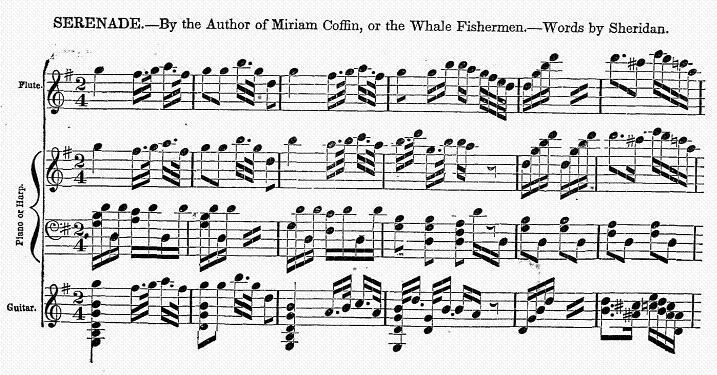
Serenade, pt.1.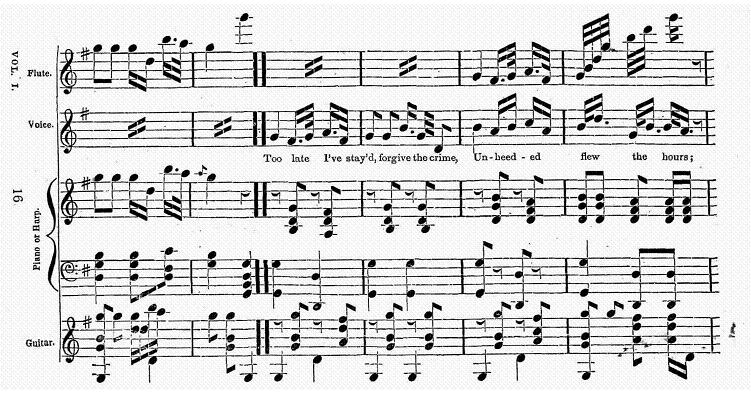
Serenade, pt.2.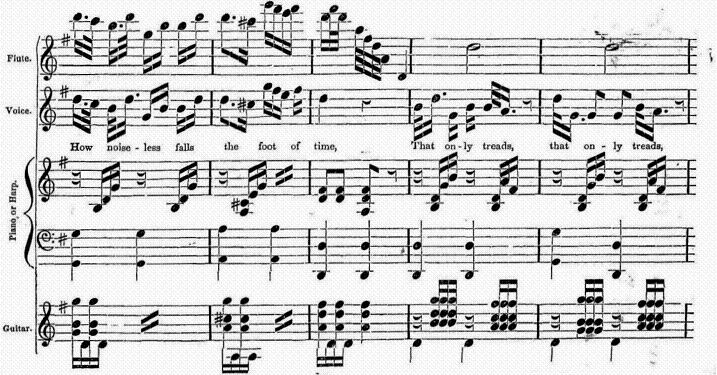
Serenade, pt.3.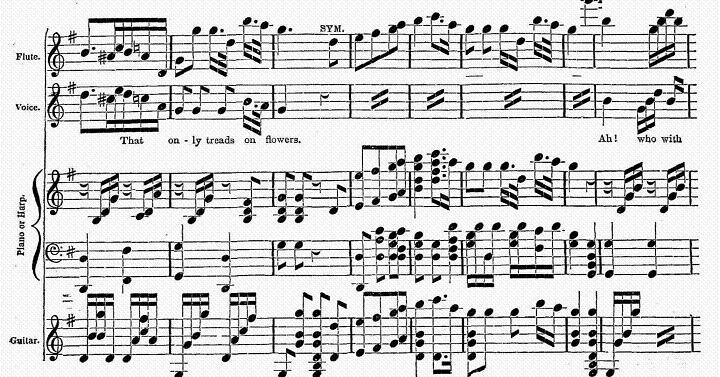
Serenade, pt.4.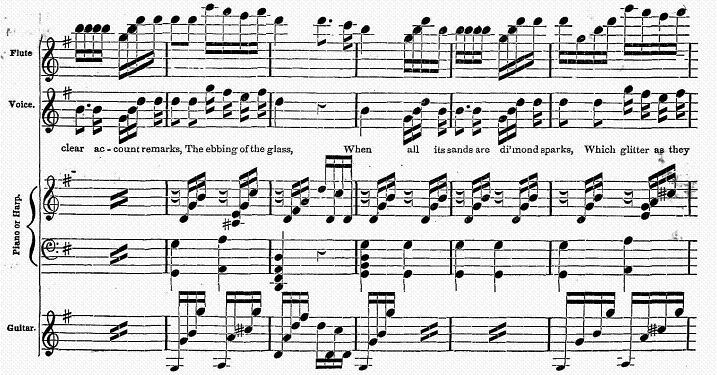
Serenade, pt.5.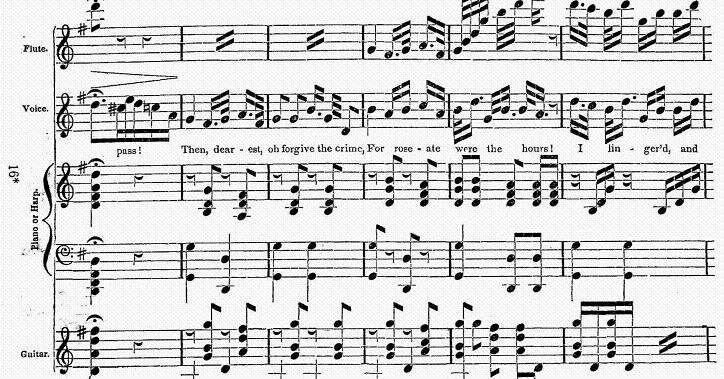
Serenade, pt.6.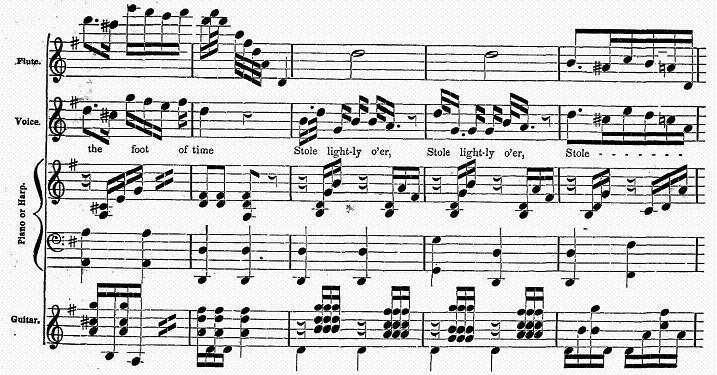
Serenade, pt.7.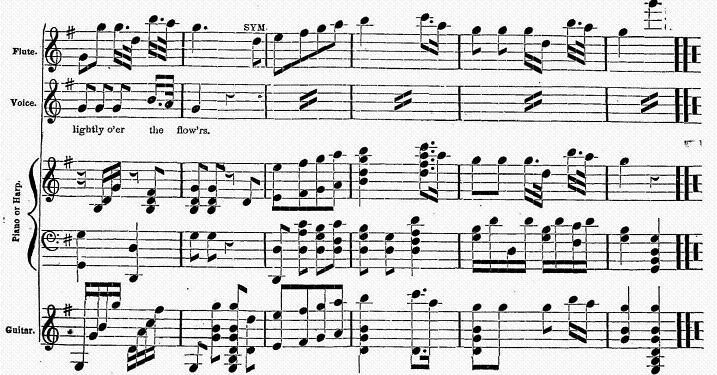
Serenade, pt.8. |
Thomas Beale.A few observations on the natural history of the sperm whale ....1835. |
ILLUSTRATIONS.
|
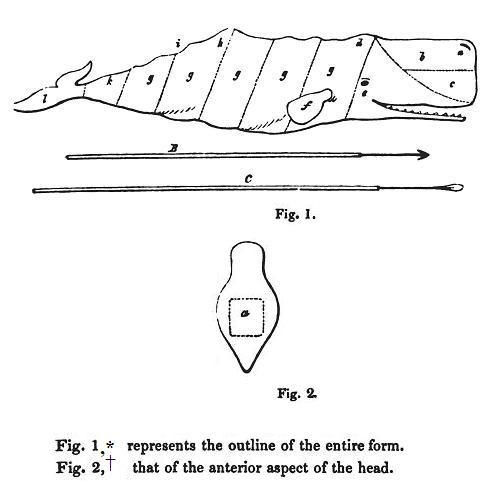
Diagram of Sperm Whale.Fig. 1.* a, the nostril or spout hole -- b, the situation of the case, c, the junk -- d, the bunch of the neck -- e, the eye -- f, the fin -- g, the spiral strips or blanket pieces -- h, the hump -- i, the ridge-- k, the small -- l, the tail or flukes -- B, a harpoon -- C, a lance. Fig. 2† a, the lines forming the square are intended to represent the flat anterior part of the head.
No. 2.
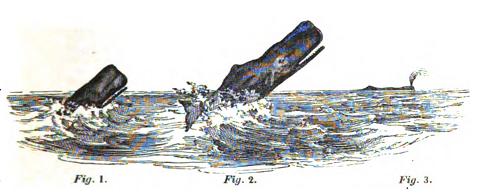
Figure No. 2.
No. 1
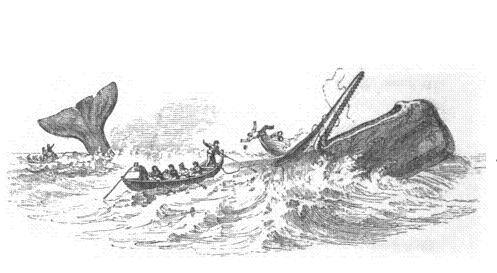
Figure No. 1.
No. 3.
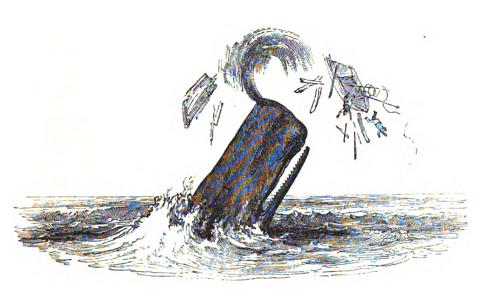
Figure No. 3.* Plate No. 3, represents a large whale in the act of destroying a boat, with his head; of this occurrence the author was an eye-witness off the coast of Japan, on July 18th, 1832. Capt. W. Swain, of the Sarah and Elizabeth, of London, had with two other boats been engaged in chasing a large whale nearly the whole of the day; at about 4 p.m. the captain was considerably a-head of the other two boats, and had succeeded in striking the whale with the harpoon, and being a dexterous whaler, he succeeded in lancing the animal twice before it had recovered itself from the blow; the lance wounds having penetrated the cavity of the chest, caused the animal to eject blood from the nostril in large quantities; he however suddenly descended to the depth of about 40 fathoms, and as suddenly rose, striking the boat with excessive force, which threw it into the air in fragments, with the men and every thing contained therein; the |
Thomas Beale.The natural history of the sperm whale ....1839. |
ILLUSTRATIONS.
|
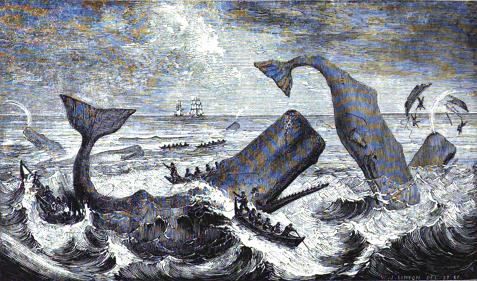
Boats Attacking Whales.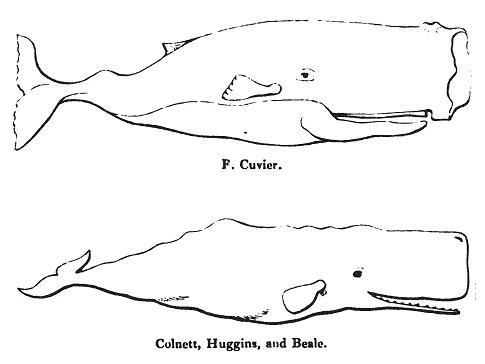
Whales of F. Cuvier and Colnett, Huggins, and Beale.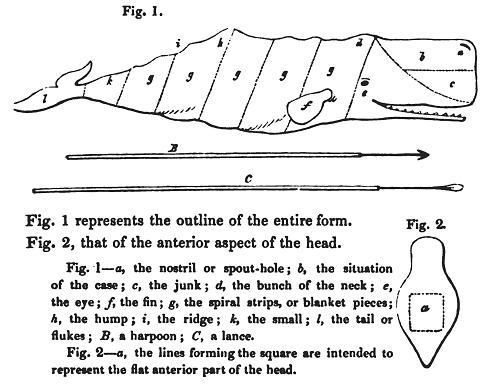
Diagram of Sperm Whale.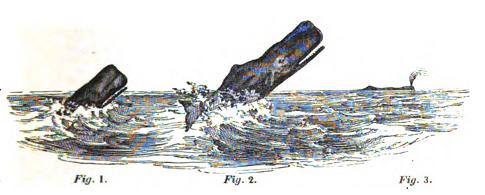
Three postures of the sperm whale.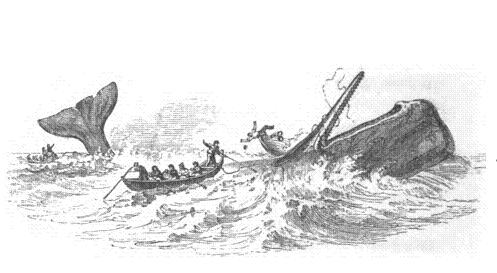
Lancing the whale.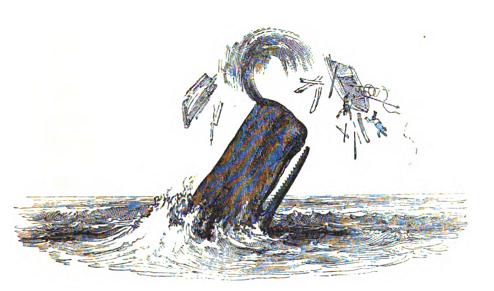
Boat being upset.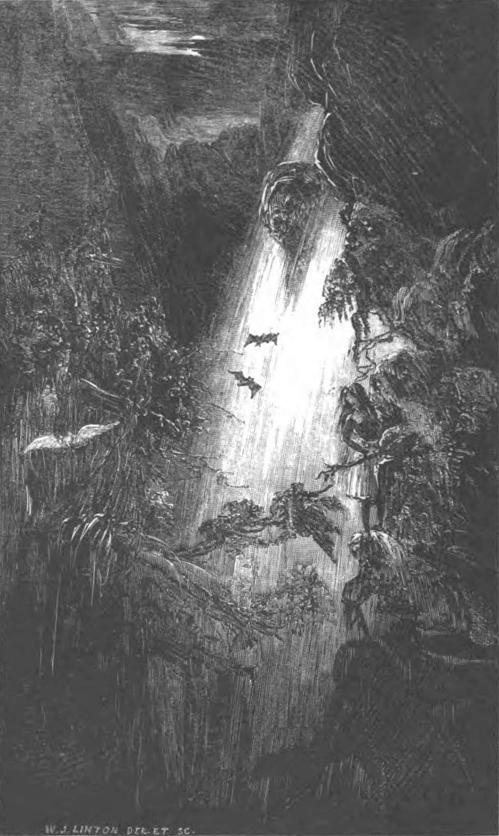 Kinau Descending the Pele of Nuanu.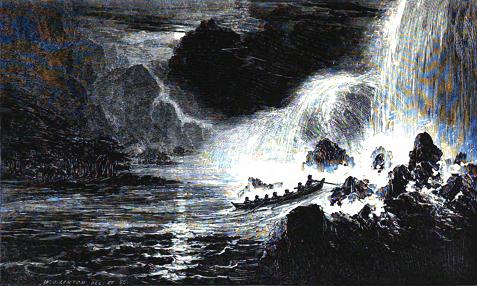
Bonin Island – Boat Passing Through the Breakers. |
Frederick Debell Bennett.Narrative of a whaling voyage round the globe, from the year 1833 to 1836, vol. 1.1840. |
ILLUSTRATIONS.
|
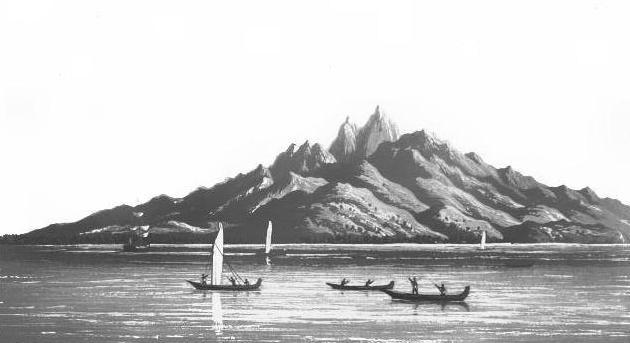
TahitiNorth-West CoastA Chart Shewing the Tracks of the South Seaman "Tuscan", in a Voyage round the World, from the Year 1833 to 1836.[Click to enlarge image]
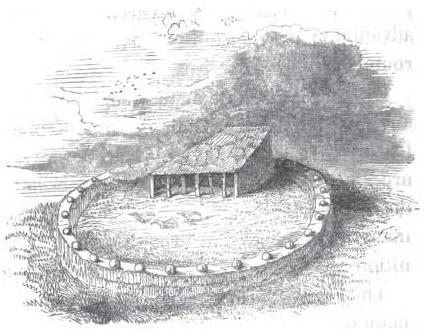
Tomb of Eutiti's child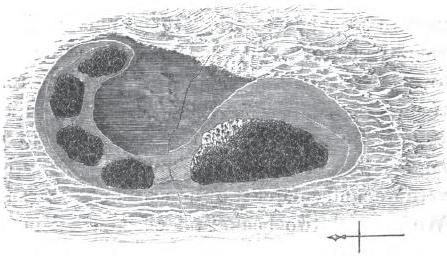
Caroline Island |
Frederick Debell BennettNarrative of a whaling voyage round the globe, from the year 1833 to 1836, vol. 2.1840. |
ILLUSTRATIONS.
|
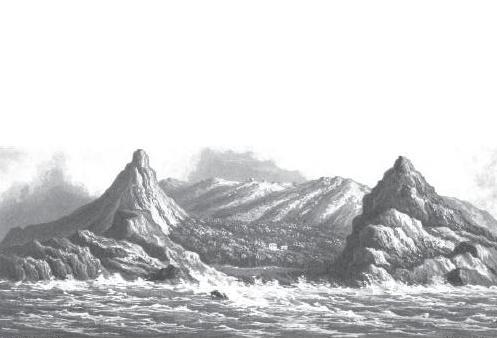
Pitcairn's Island
|
Richard Henry Dana, Jr.The Seaman's Friend; Containing a Treatise on Practical Seamanship, with Plates, a Dictionary of Sea Terms; Customs and Usages of the Merchant Service; Laws Relating to the Practical Duties of Master and Mariners.1841. |
ILLUSTRATIONS.
|
Index of References.
Index of References.
Index of References.
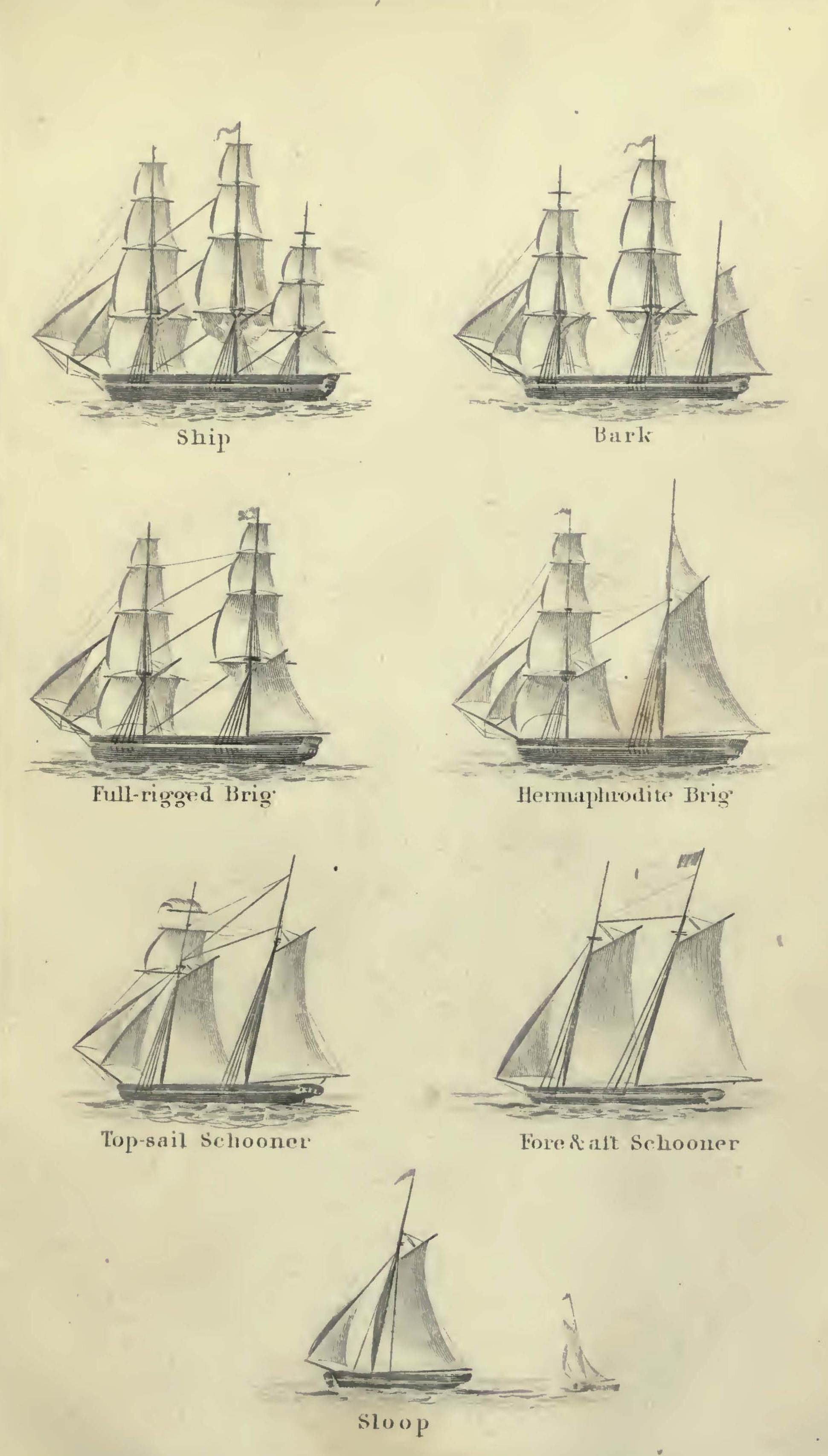
Plate IV.
Explanations.Ship. – A ship is square-rigged throughout; that is, she has tops, and carries square sails on all three of her masts. Bark. – A bark is square-rigged at her fore and main masts, and differs from a ship in having no top, and carrying only fore-and-aft sails at her mizzenmast. Brig. – A full-rigged brig is square-rigged at both her masts. Hermaphrodite Brig. – An hermaphrodite brig is square-rigged at her foremast; but has no top, and only fore-and-aft sails at her main mast. Topsail Schooner. – A topsail schooner has no tops at her foremast, and is fore-and-aft rigged at her mainmast. She differs from an hermaphrodite brig in that she is not properly square-rigged at her foremast, having no top, and carrying a fore-and-aft foresail, in stead of a square foresail and a spencer. Fore-and-aft Schooner. – A fore-and-aft schooner is fore-and-aft rigged throughout, differing from a topsail schooner in that the latter carries small square sails aloft at the fore. Sloop. – A sloop has one mast, fore-and-aft rigged. Hermaphrodite Brigs sometimes carry small square sails aloft at the main; in which case they are called Brigantines, and differ from a Full-rigged Brig in that they have no top at the mainmast, and carry a fore-and-aft mainsail instead of a square mainsail and trysail. Some Topsail Schooners carry small square sails aloft at the main as well as the fore; being in other respects fore-and-aft rigged. They are then called Main Topsail Schooners. | ||||||||||||||||||||||||||||||||||||||||||||||||||||||||||||||||||||||||||||||||||||||||||||||||||||||||||||||||||||||||||||||||||||||||||||||||||||||||||||||||||||||||||||||||||||||||||||||||||||||||||||||||||||||||||||||||||||||||||||||||||||||||||||||||||||||||||||||||||||||||||||||||||||||||||||||||||||||||||||||||||||||||||||||||||||||||||||||||||||||||||||||||||||||||||||||||||||||||||||||||||||||||||||||||||||||||||||||||||||||||||||||||||||||||||||||||||||||||||||
Francis Allyn Olmsted.Incidents of a whaling voyage: to which are added observations on the scenery manners and customs, and missionary stations of the Sandwich and Society Islands ...1841. |
ILLUSTRATIONS.
|
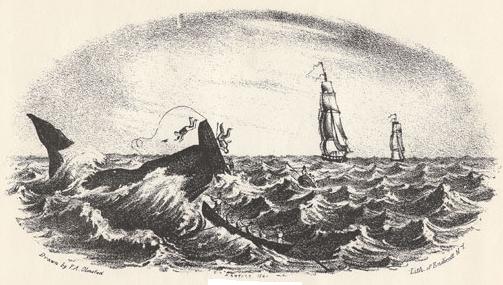
Perils of Whaling.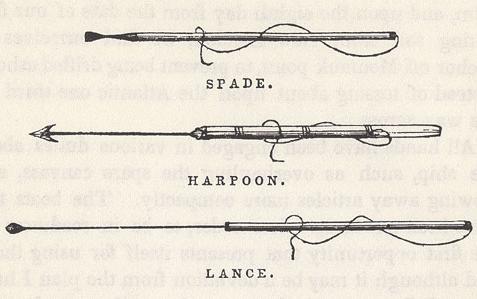
Spade, Harpoon, & Lance.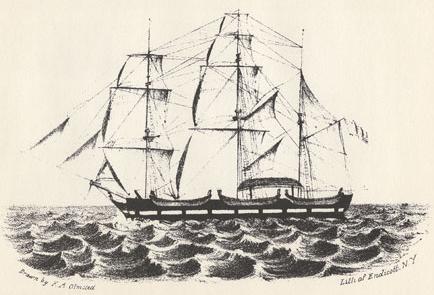
Barque North America - New London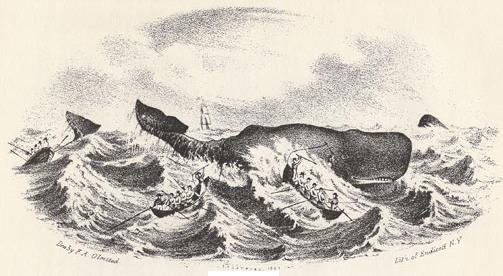
The Attack.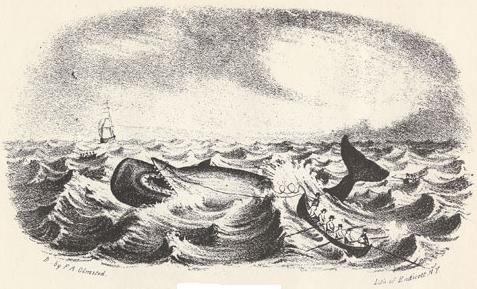
The Dying Whale.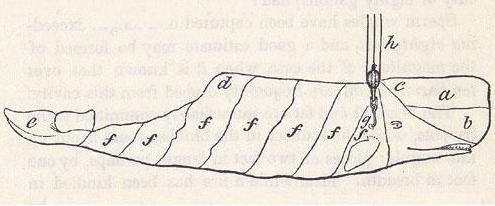
Sperm Whale Diagram.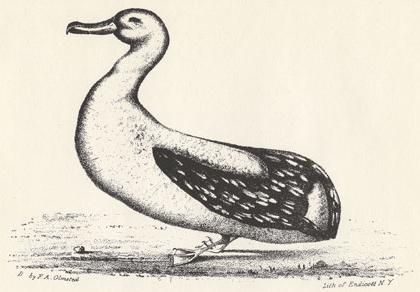
Albatross.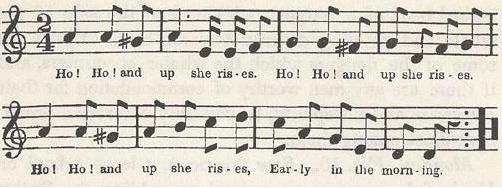
Ho! Ho! and up she rises.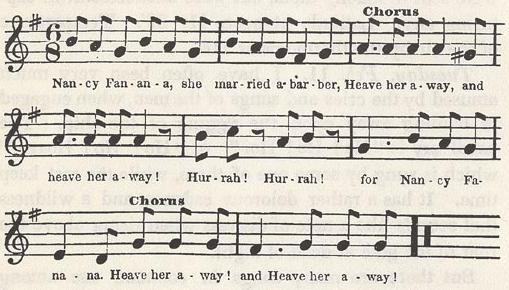
Nancy Fanana.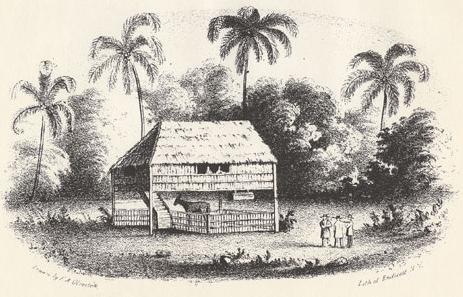
Spanish House Tacames S. America.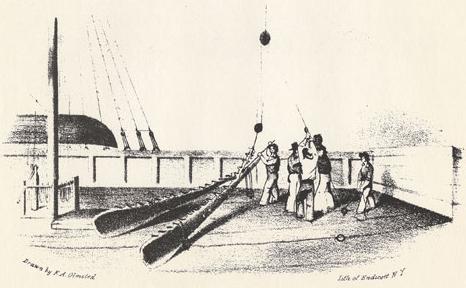
Pulling Teeth.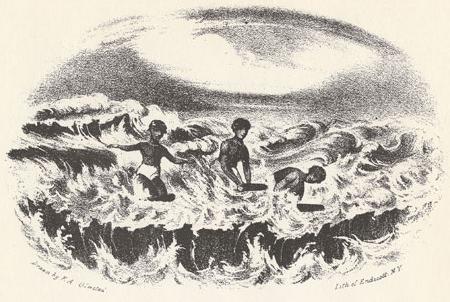
Sandwich Islanders Playing in the Surf.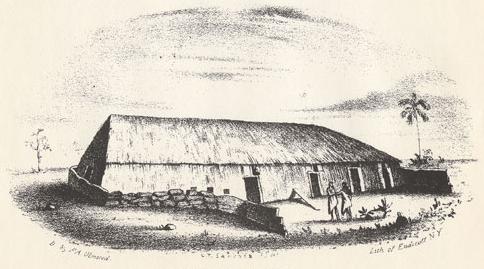
Old Native Church Honolulu.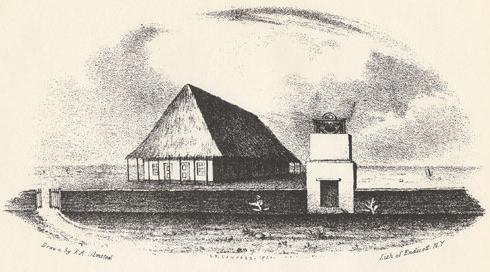
Native Church. Honolulu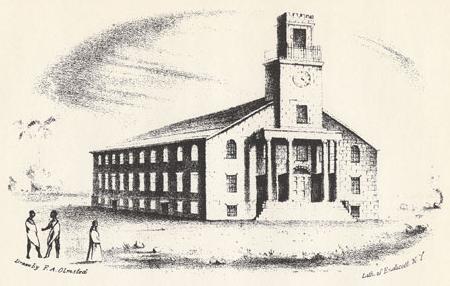
New Native Church - Honolulu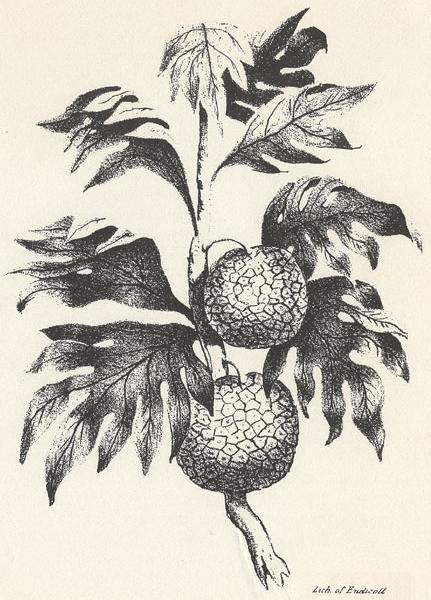
Bread Fruit.
|
Charles DarwinJournal of researches into the natural history and geology of the countries visited during the voyage of H. M. S. Beagle round the world, under the command of Capt. Fitz Roy, R.N.1845. |
ILLUSTRATIONS.
|
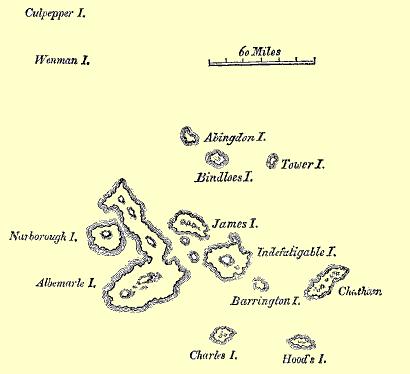
Map of the Galapagos Islands.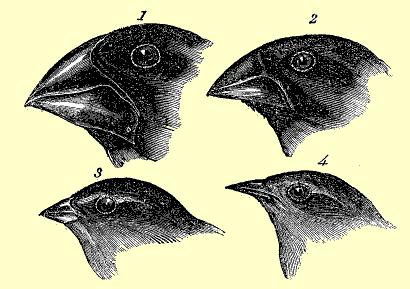
Four Finches. |
J. Ross Browne.Etchings of a whaling cruise, with notes of a sojourn on the island of Zanzibar. To which is appended a brief history of the whale fishery.1846. |
ILLUSTRATIONS.
|
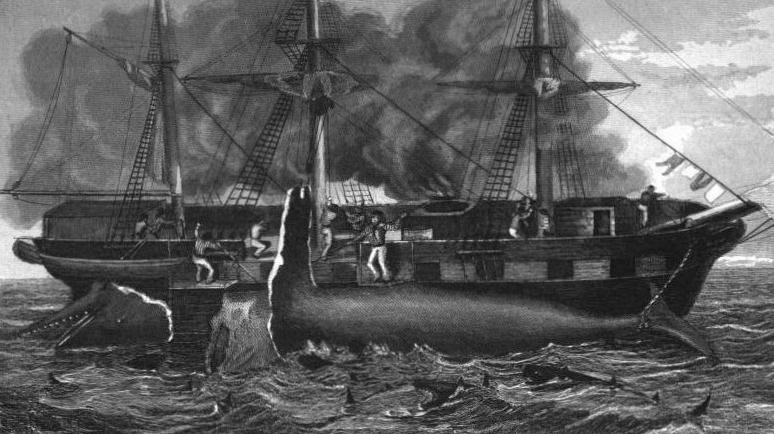
Cutting in & Trying Out.
Harpoon.
The Lance.
The spade.The Boarding Knife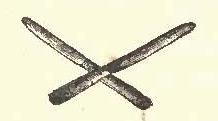
Blubber Knives.
The Mincing Knife.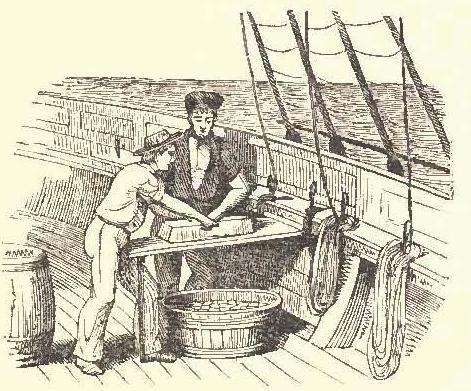
Mincing Table.
The Fork.
The Strainer.
The Dipper.
The Pike.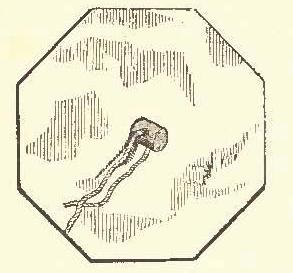
The "Drag".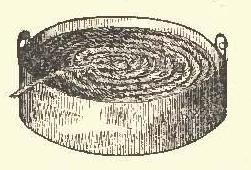
The "Tub".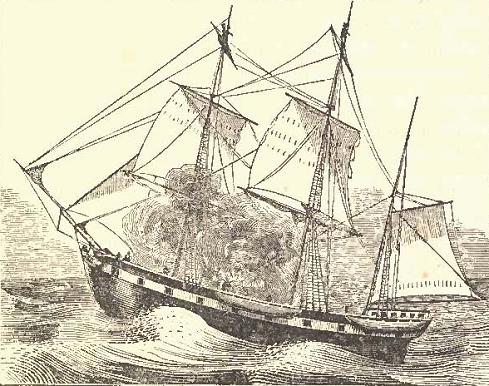
Trying Out - Whaling Bark.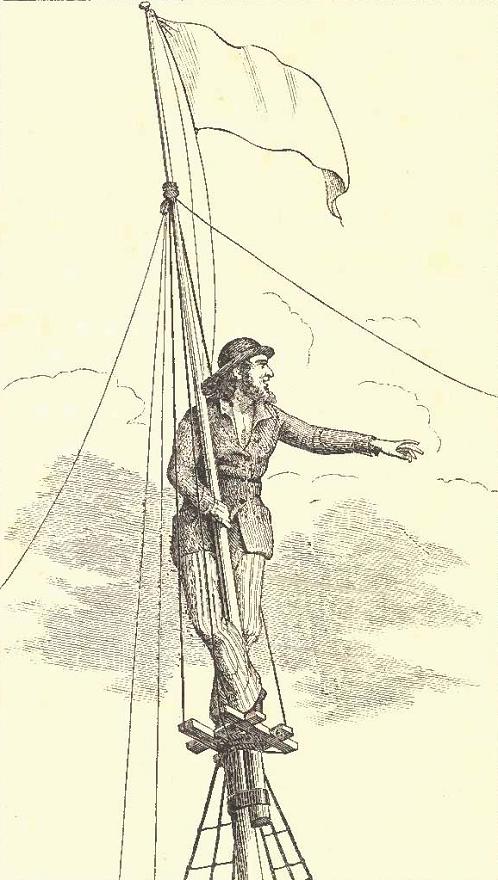
Man at the Mast-head.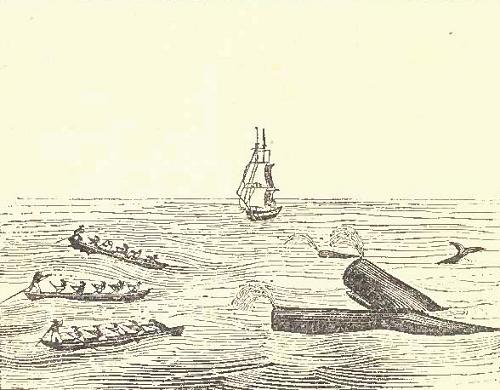
Three Boats Hunting Whales.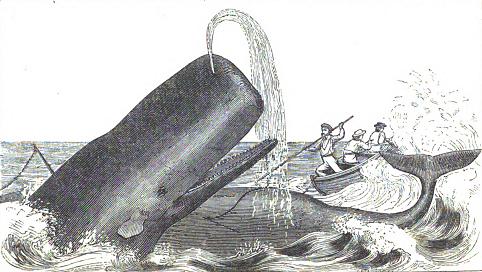
Lancing a Whale.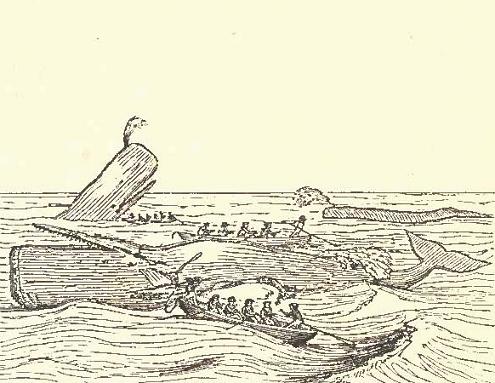
Dead whale.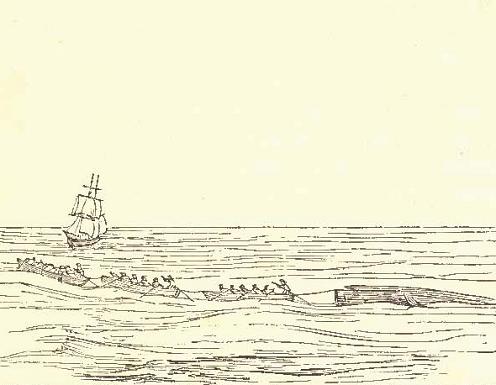
Towing a Dead Whale.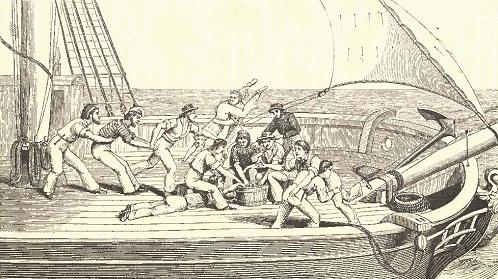
A Scramble for Salt Junk.
John Tabor's Ride.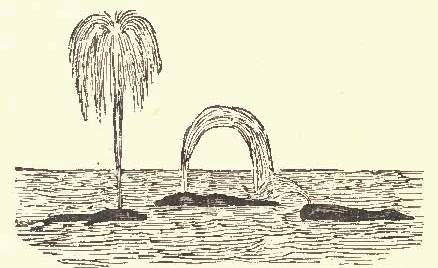
Whale spouts.
|
Henry T. CheeverThe whale and his captors; or, The whalemen's adventures, and the whale's biography as gathered on the homeward cruise of the "Commodore Preble"1850. |
LIST OF ENGRAVINGS
|
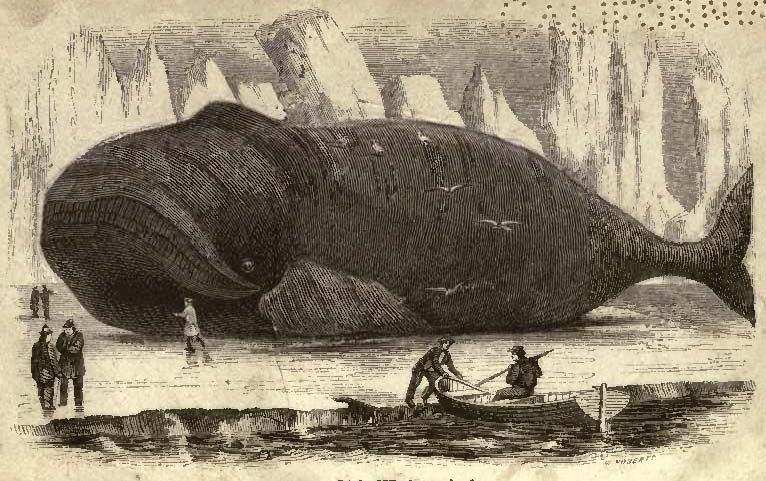
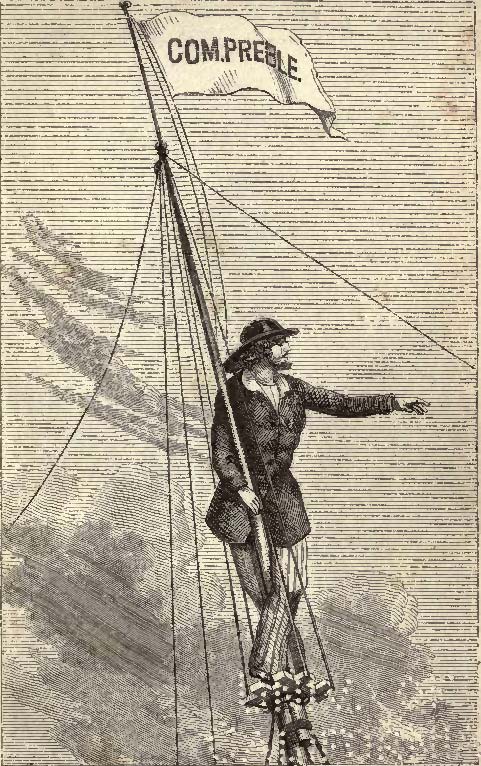
There she blows! There she blows!
Such a prize we must not lose! |
|
Launch the harpoon! Laugh at fear! Plunge it deep, the barbed spear! Strike the lance in swift career! Give her line! Give her line! Down she goes through the foaming brine. |
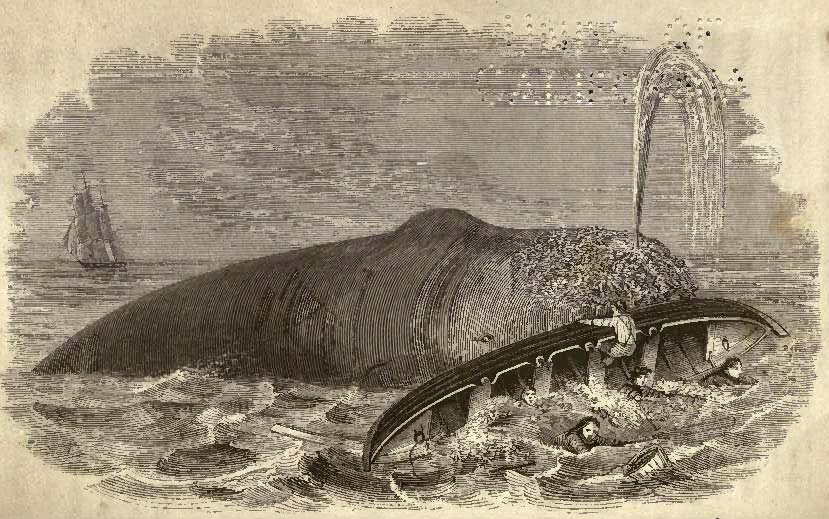
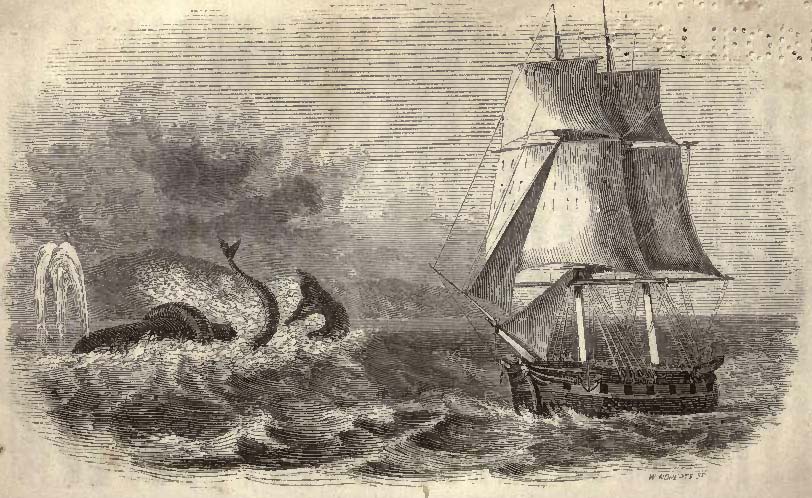
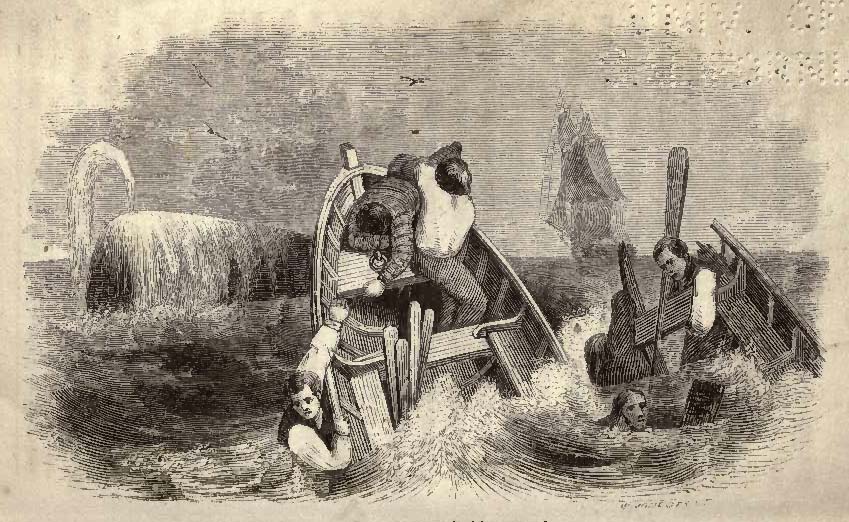
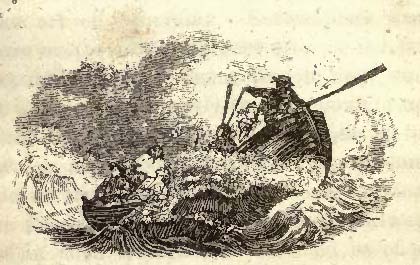
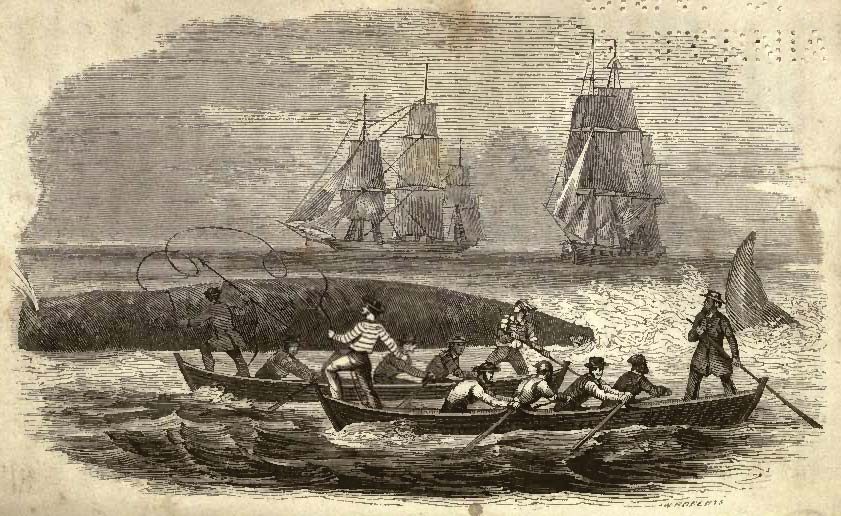
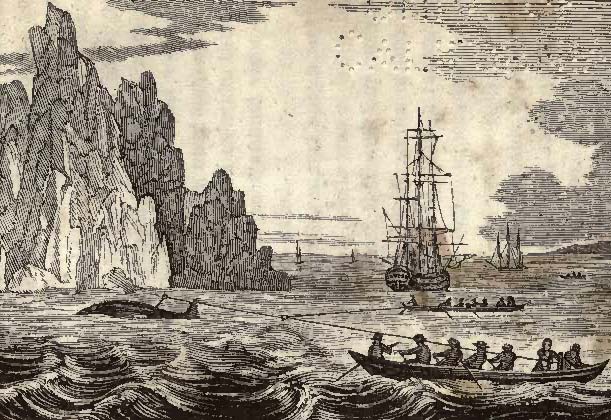
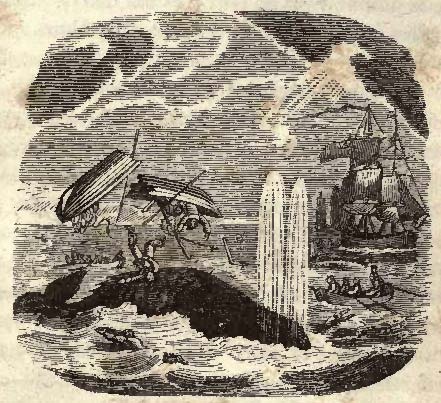
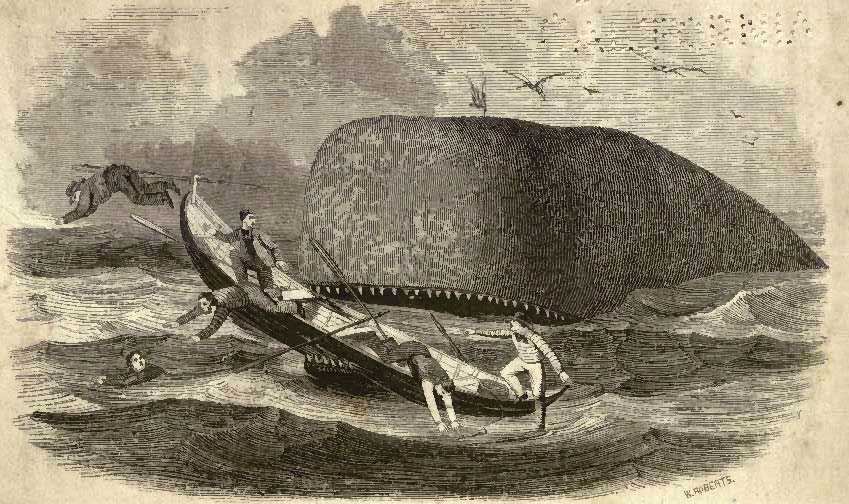
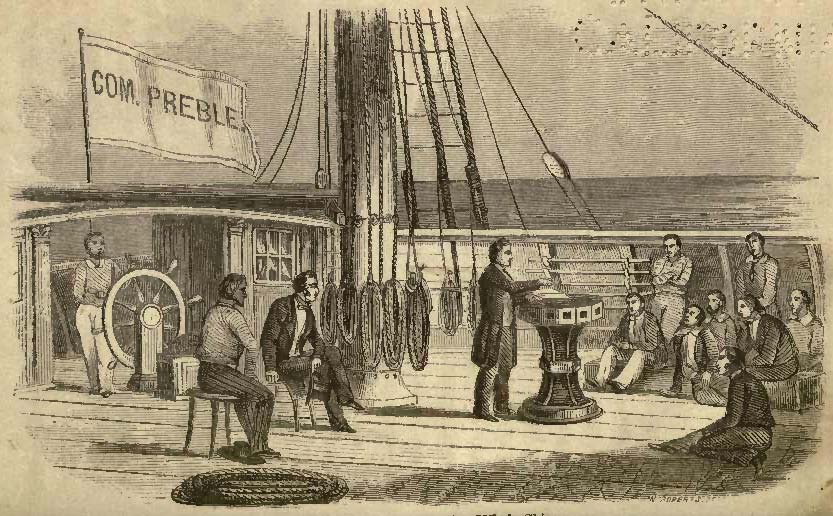
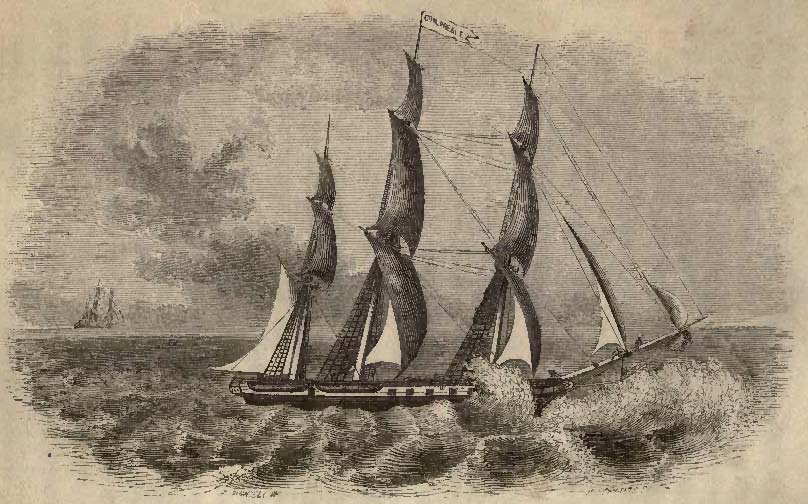
Matthew Calbraith PerryNarrative of the expedition of an American squadron to the China Seas and Japan : performed in the years 1852, 1853, and 1854, under the command of Commodore M.C. Perry, United States Navy, ....1856. |
ILLUSTRATIONS.
|
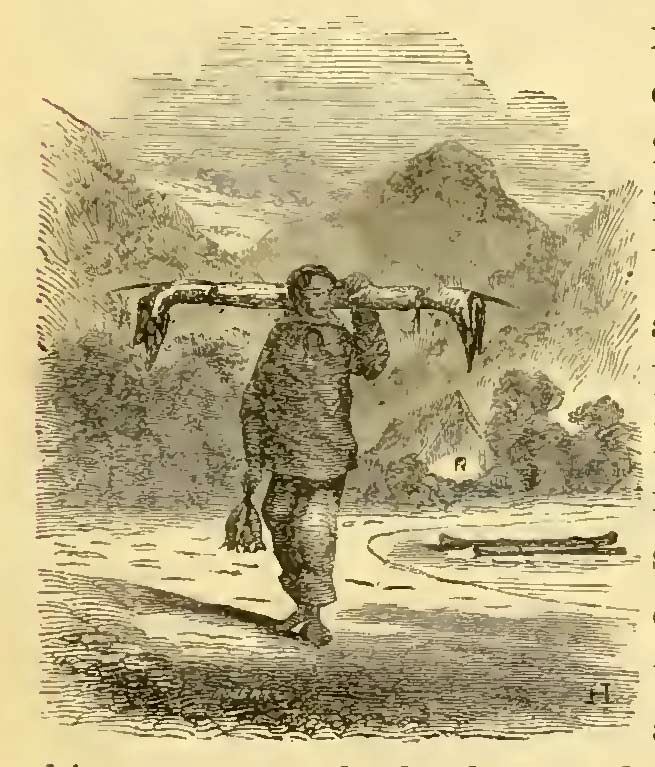
Vignette of a Bonin Island Native.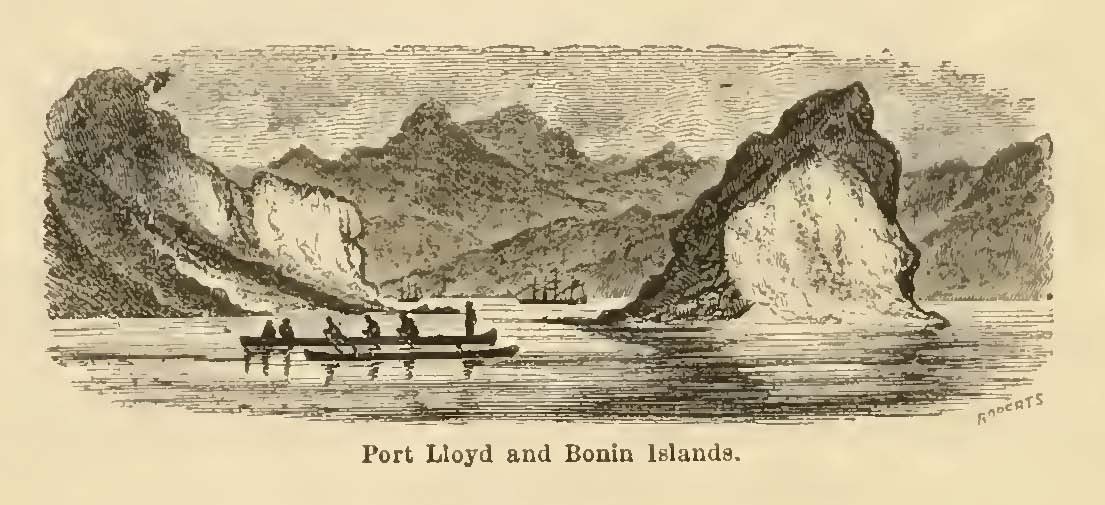
Port Lloyd and Bonin Islands. |
William M. Davis.Nimrod of the sea; or, The American whaleman.1874. |
ILLUSTRATIONS.
|
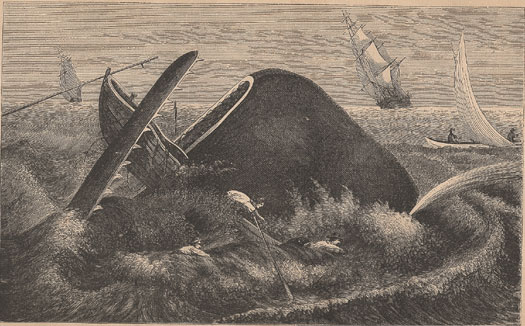 In the Whale's Jaw.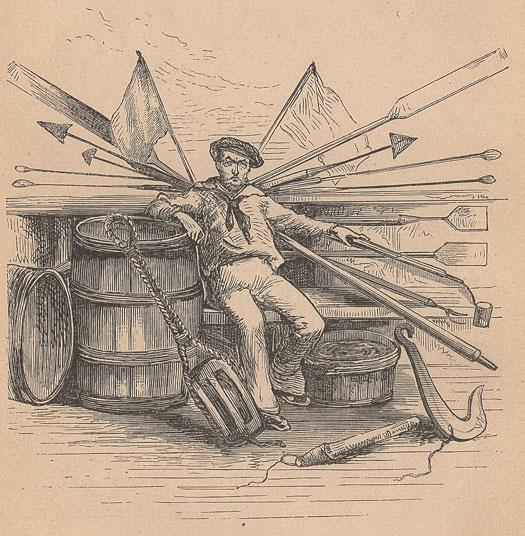 Title page image.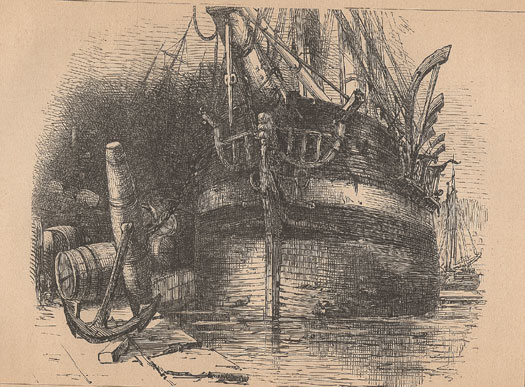 Been Aboard The Chelsea Yet?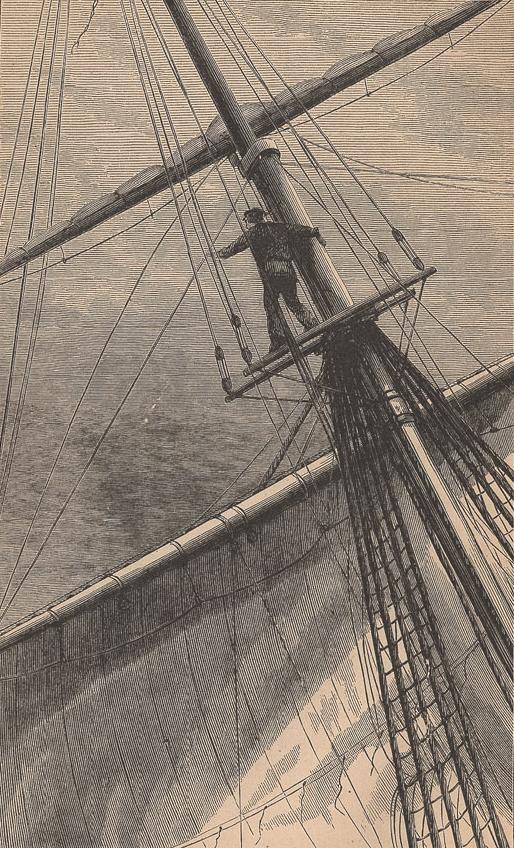 "There She Blows!"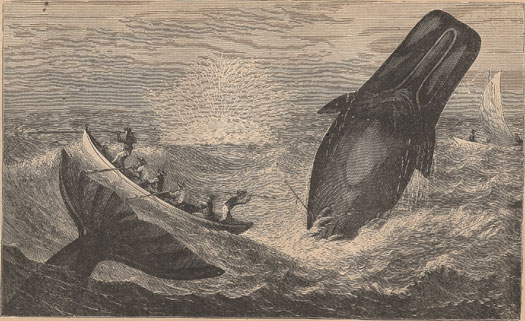
Struck on a Breach.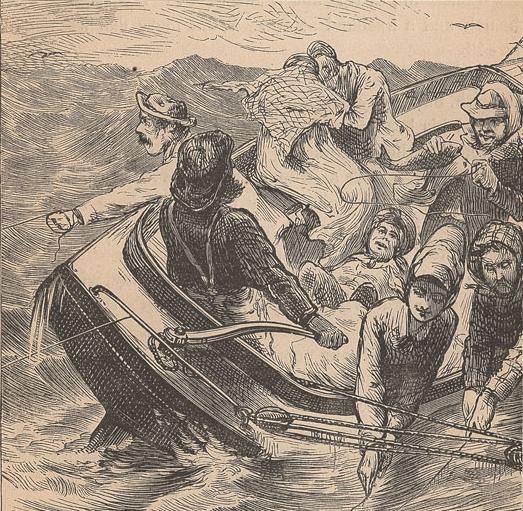
Nantucket Schooling.div class="center">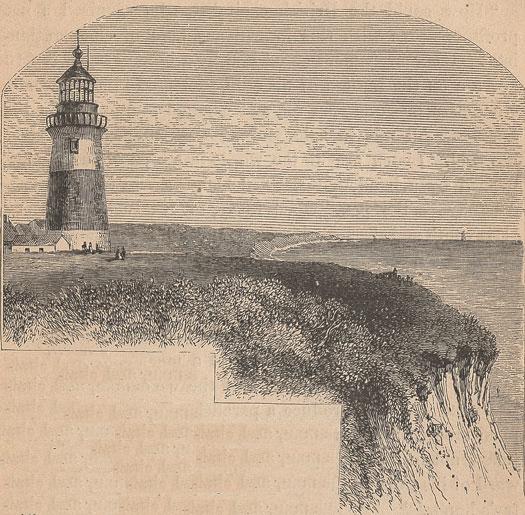
Light-House, Sankaty Head.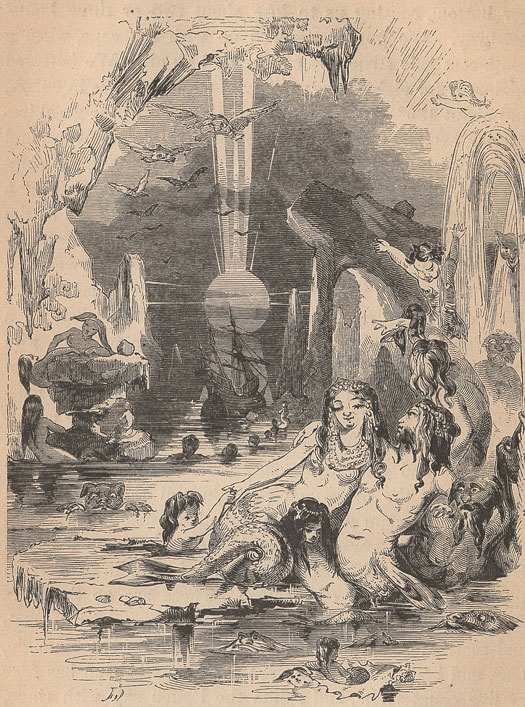
The Sea Beyond the Shining Wall.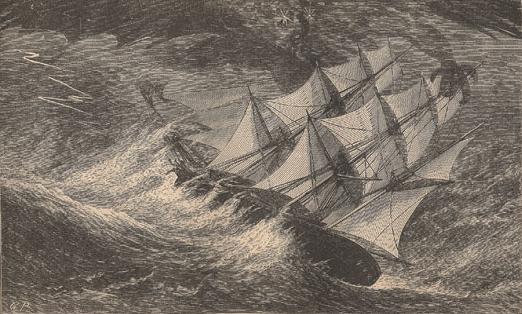
Captain Folger's Luck.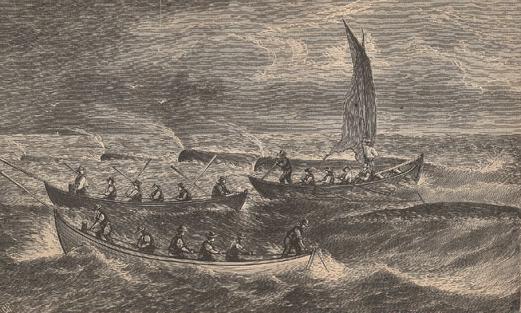
In a School.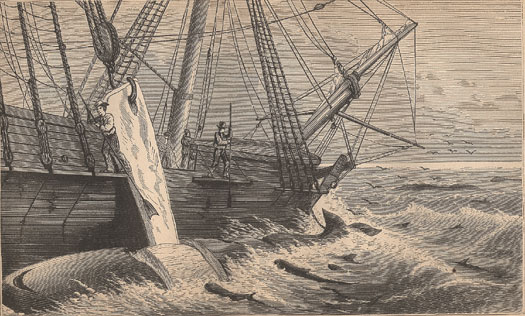
"Cutting In".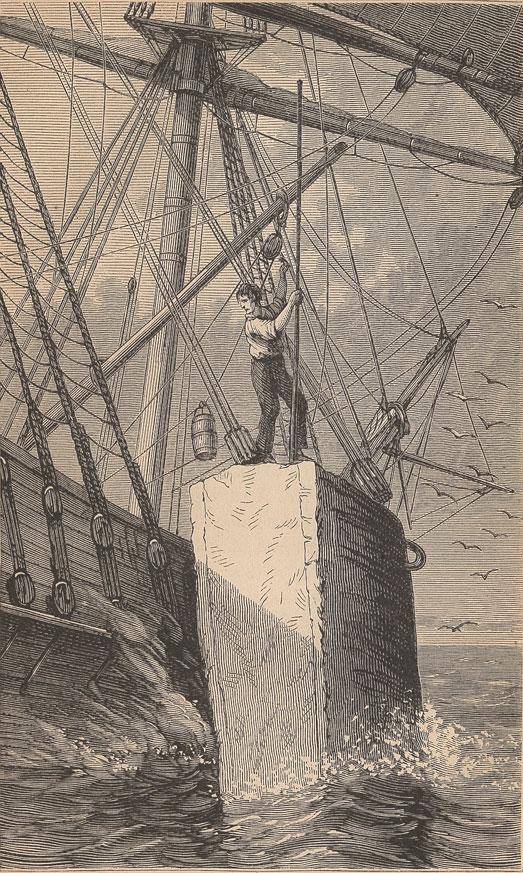
Bailing the "Case".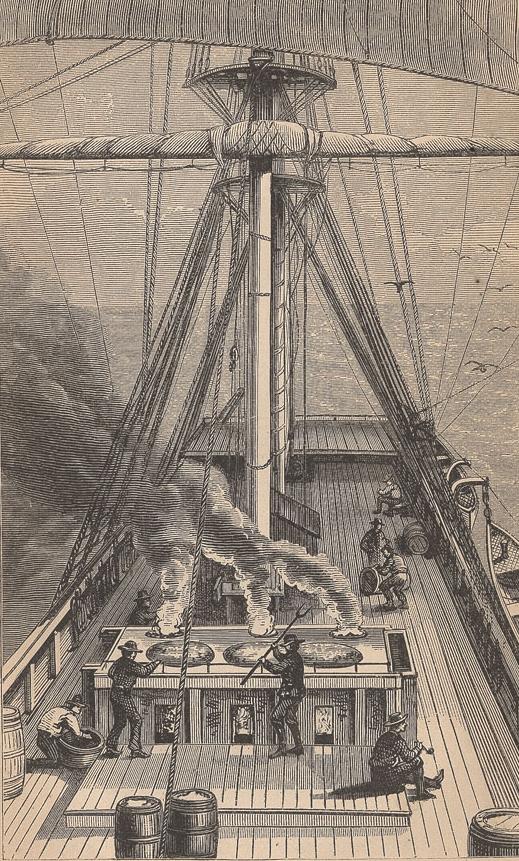
Trying Out.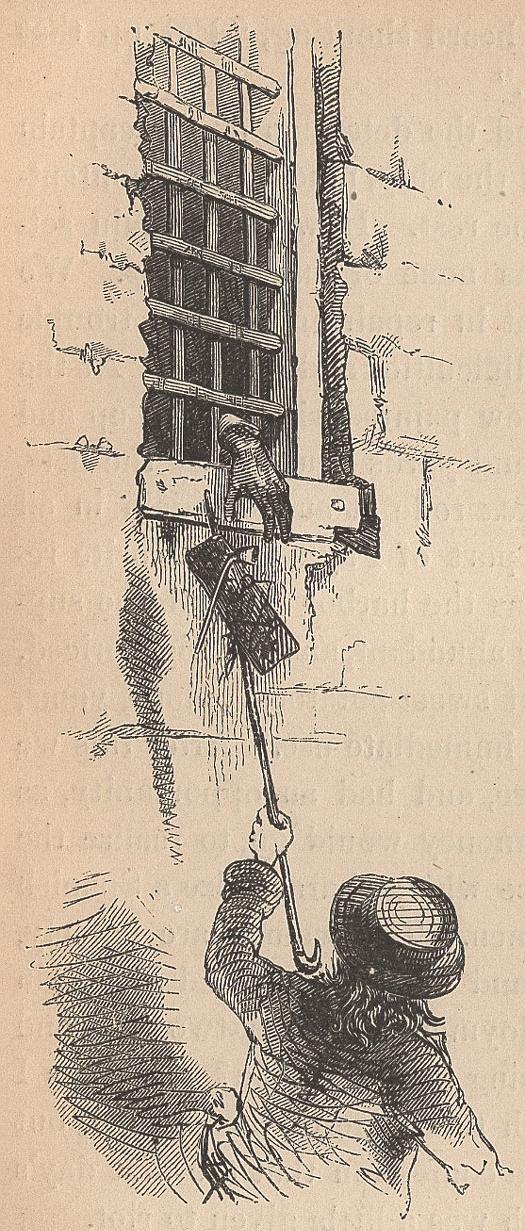
The Prisoner.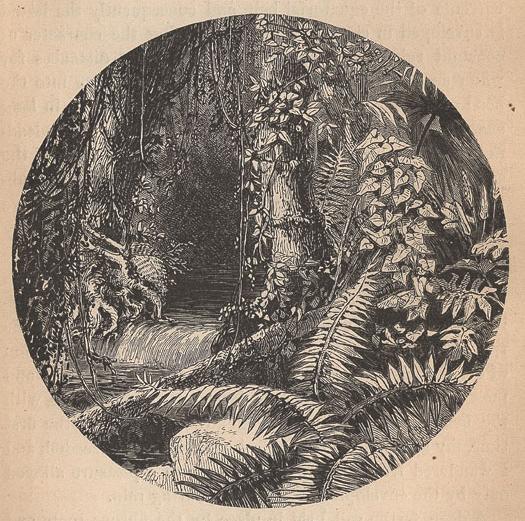
Tropical Growths.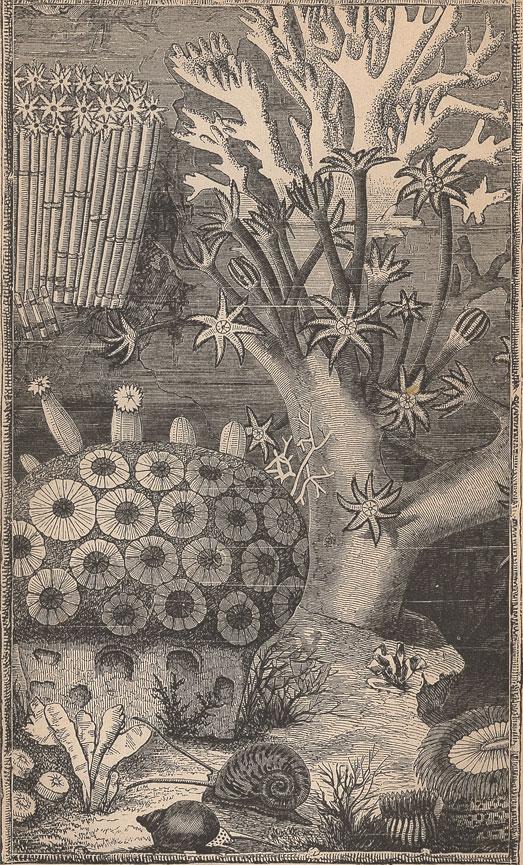
Corals and Madrepores.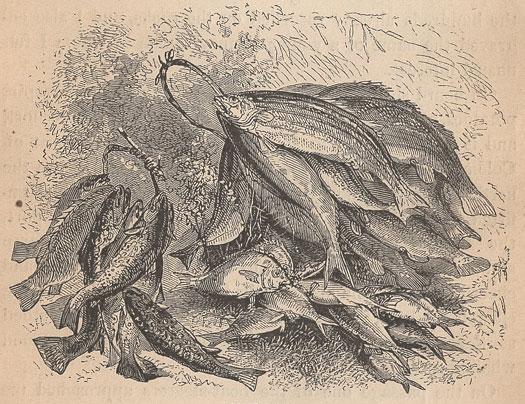
Some Fish.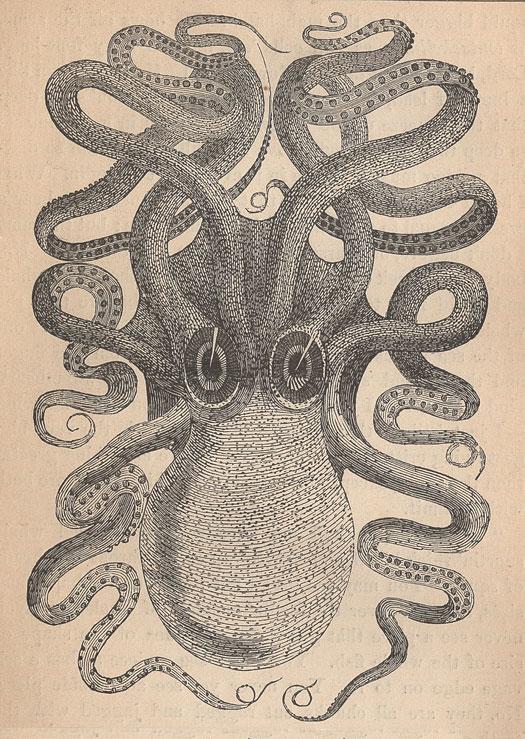
Eight-Armed Cuttle-Fish (Sepia Octopus).– Front View.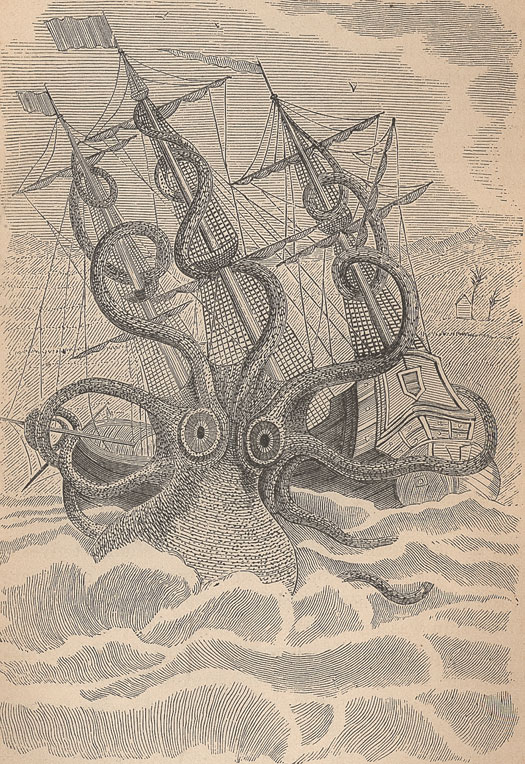
Memorial Picture.
|
Harper's New Monthly Magazine."Huntsmen of the Sea"Volume 49, Issue 293, October 1874. pp. 650-661. |
ILLUSTRATIONS.
|
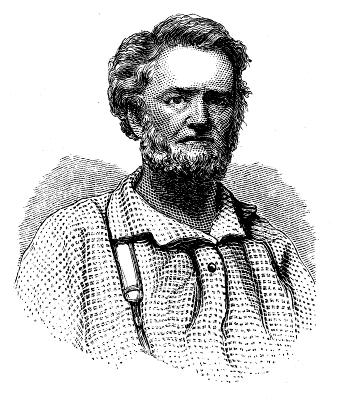 A Nimrod of the Sea.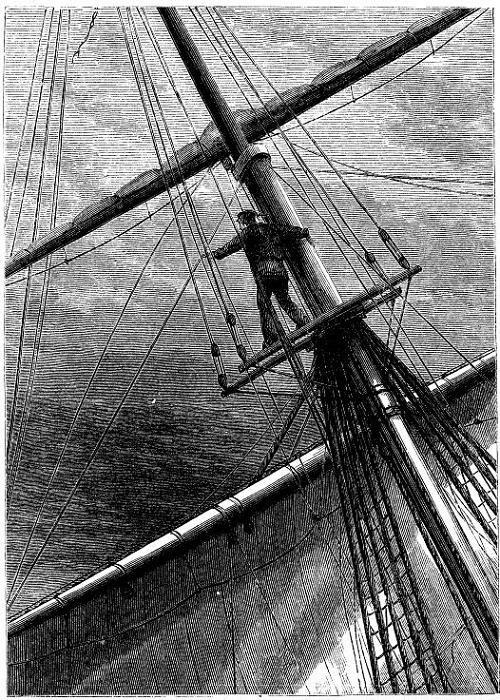 "There She Blows!"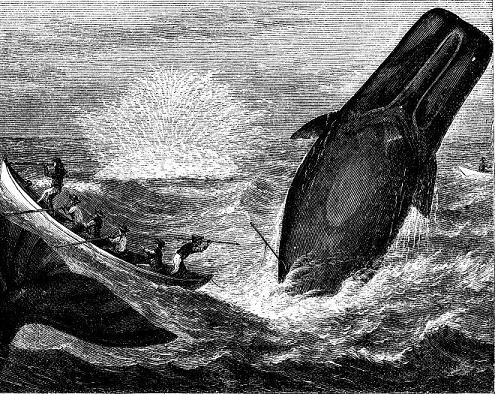 Struck on a Breach.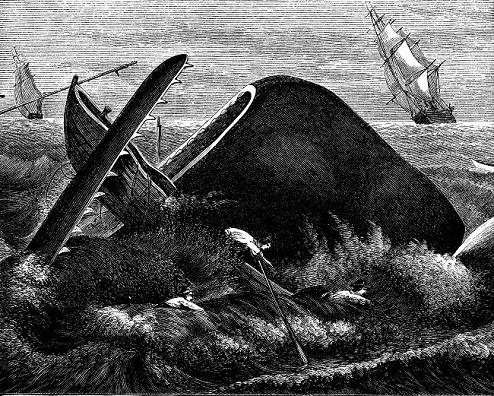 In the Whale's Jaws.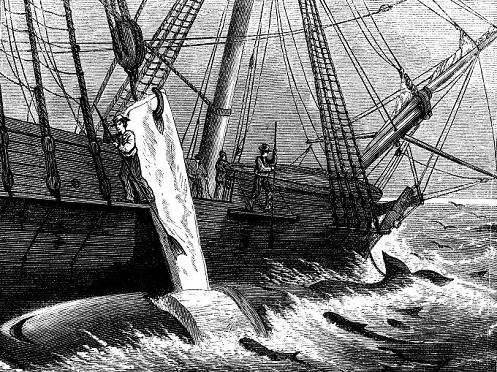 "Cutting In."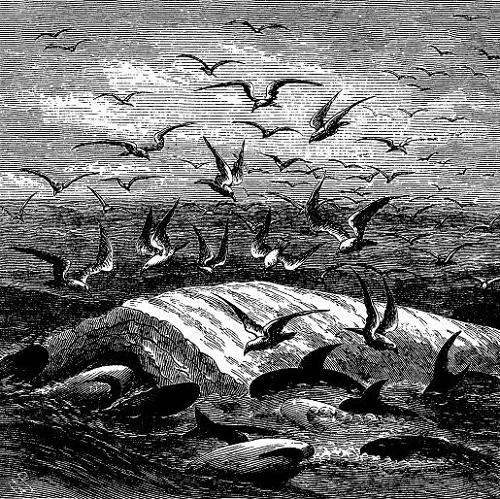 Carcass Adrift.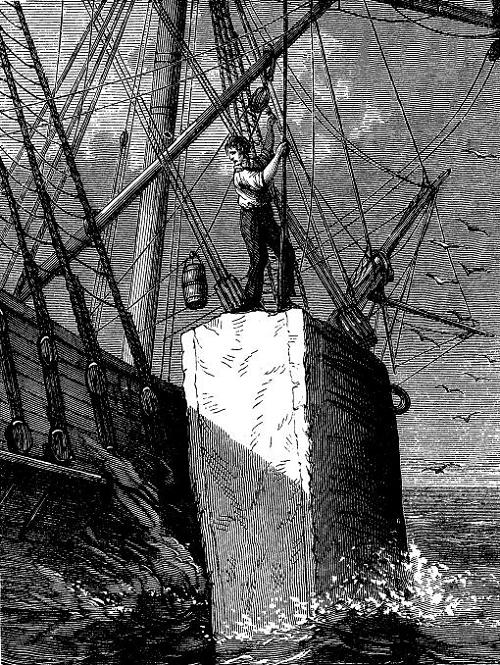 Bailing the "Case".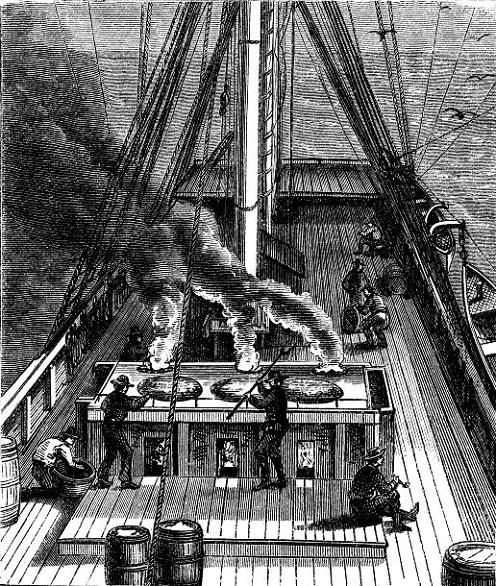 "Trying Out." |
Alexander StarbuckHistory of the American Whale Fishery from its Earliest Inception to the Year 18761878. |
LIST OF ILLUSTRATIONS.
* The figures of whales and of apparatus used in the whale-fisheries are taken from the important and remarkably interesting volume entitled "The Marine Mammals of the Northwestern Coast of North America described and illustrated; together with an account of the American Whale-Fishery." By Charles M. Scammon, Captain United States Revenue Marine. San Francisco: John H. Carmany & Co. New York: G. P. Putnam & Sons. 1874. 4to. 27 plates. | ||||||||||||||||||||||||||||||||||||||||||||||||||||||||||||||||||||||||||||||||||||||||||||||||||||||||||||||||||||||||||||||||||||||

Diagram for Cutting In from Scammon's "Marine Mammalia"†.† The difference between "head" and "body" matter of the sperm whale can be best understood by reference to the following description of cutting in and diagram copied from Scammon's "Marine Mammalia:" "The first procedure after the animal is fastened to the ship, is to cut a hole through the blubber, between the eye and fin, at A, as seen in the accompanying outline sketch, then, after cutting the scarfs on each side and around the end of the first blanket-piece, a blubber-hook, attached to one of the cntting-tackles, is inserted into the hole at A, and the piece raised by means of the tackle until the whale is rolled on its side; then the line of separation between the upper jaw and junk is cut, as from L to C, and if a large whale, the line of separation is cut between the junk and case, as from B to E, and a cut is made across the root of the case from E to F; a scarf is also made around the root of the lower jaw, from near the corner of the month to G. A chain-strap is then put on the jaw near H and hooked or shackled to the second cutting-tackle, and raised by that purchase, while the other tackle attached to the piece is slackened off, if need be, so as to let the whale roll upon its back; when, by means of the tackle attached, and by cutting away the tongue and the adhering flesh, the jaw is wrenched from its socket and placed on deck. This being accomplished, the first tackle, which is attached to the piece, is hove up by means of the windlass, until the whale is rolled over to its opposite side, when the lines of separation are cut to correspond to those made opposite. Holes are then mortised through the head close to the upper jaw-bone, near I, at the end of the junk, near J, and at the root of the case, near K, and through these holes straps are rove, and lines are made fast to those of the junk and case. The second cutting-tackle is then hooked in the strap which is around the upper jaw at I; the fluke-chain is slackened off, and the first tackle fastened to the piece is lowered, when all hands heave on the head-tackle, forcing the whale down again, and thus bringing the creature's head up, and the body nearly to a vertical position. The officers upon the cutting-stage with their keen spades cat away between the bones and junk from L to C, and the enormous weight of the whole fatty mass of the head hanging down opens the gash between it and the skull-bone; then, cutting cross the end of the junk and root of the case, from E to F, completes the process of cutting off the head, which is temporarily made fast to the ship's quarter. The fluke-chain is then hauled in again, and the blubber is rolled from the body in the same manner as that of a baleen-whale, until coming to the region of the small, when it is uujointed just behind the vent, and the remaining posterior portion of the animal is hoisted on board in one mass. The head, as it is termed, is then hauled up to the gangway, and one of the tackles is hooked into the ,junk-strap at J, and by means of this cutting-tackle purchase, the head is taken in whole, if the whale is under forty barrels; but if over that size, it is raised suflieiently out of the water to cut the junk from the case, when it is hoisted on deck. The case is then secured by one or both tackles, hove up to the plank-sheer, and an opening is made at ts root, of a suitable size to admit the case-bucket, when the oil is bailed out, or the whole case is hove in on deck before being opened; which finishes the cutting-in of a sperm-whale." The "head" or case oil is, when bailed out, as clear and limpid as water, but after a short time thickens and hardens into a mass as purely white as the newly fallen snow. The body oil is of a coarser nature. For all practical purposes, the general principles of "cutting-in" the sperm-whale will apply to the same process in regard to the right or bone whale; and for a thorough description of these cetaceans, the implements used in their capture, and the saving of the oil, the work quoted above will be found an excellent authority. 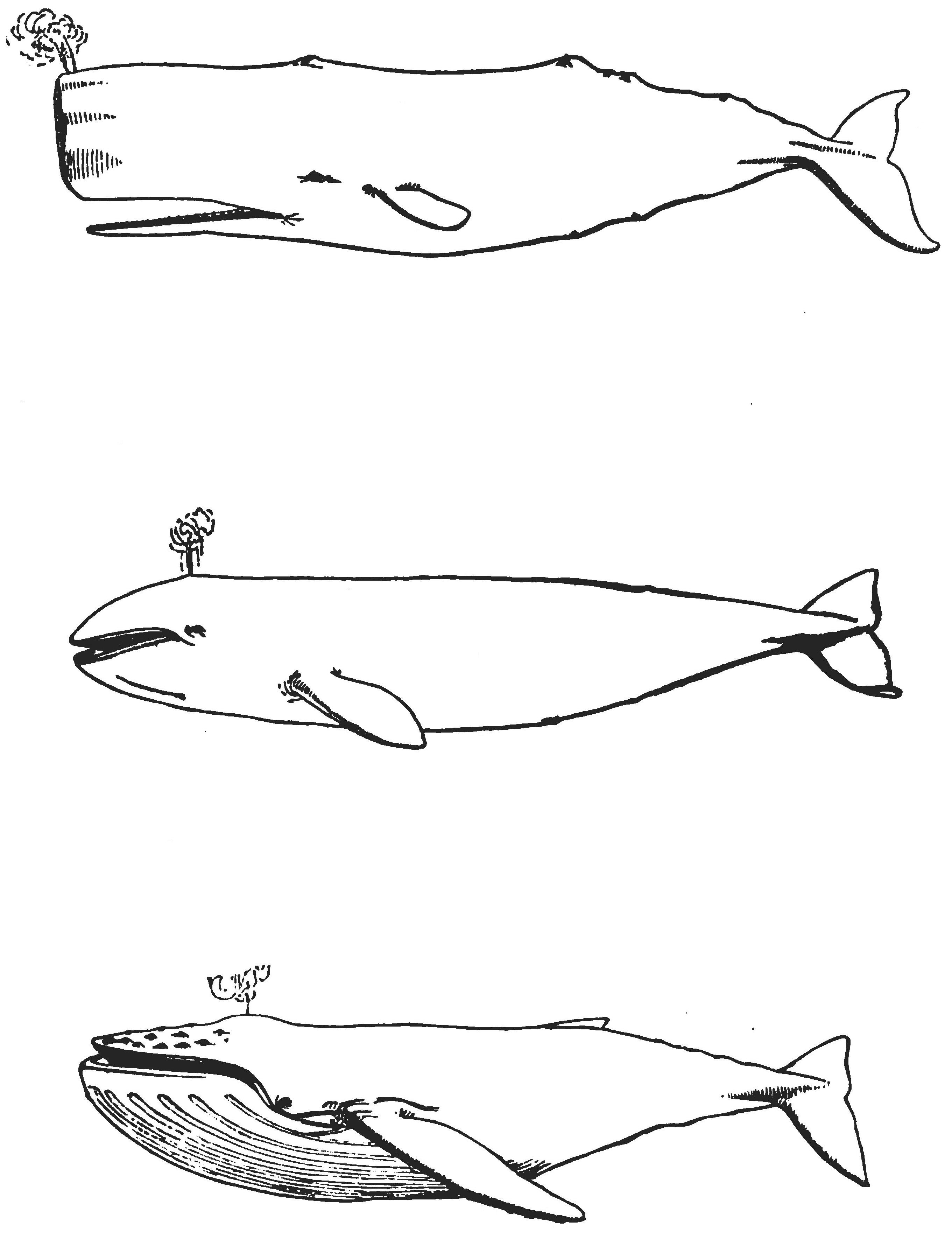
Plate I.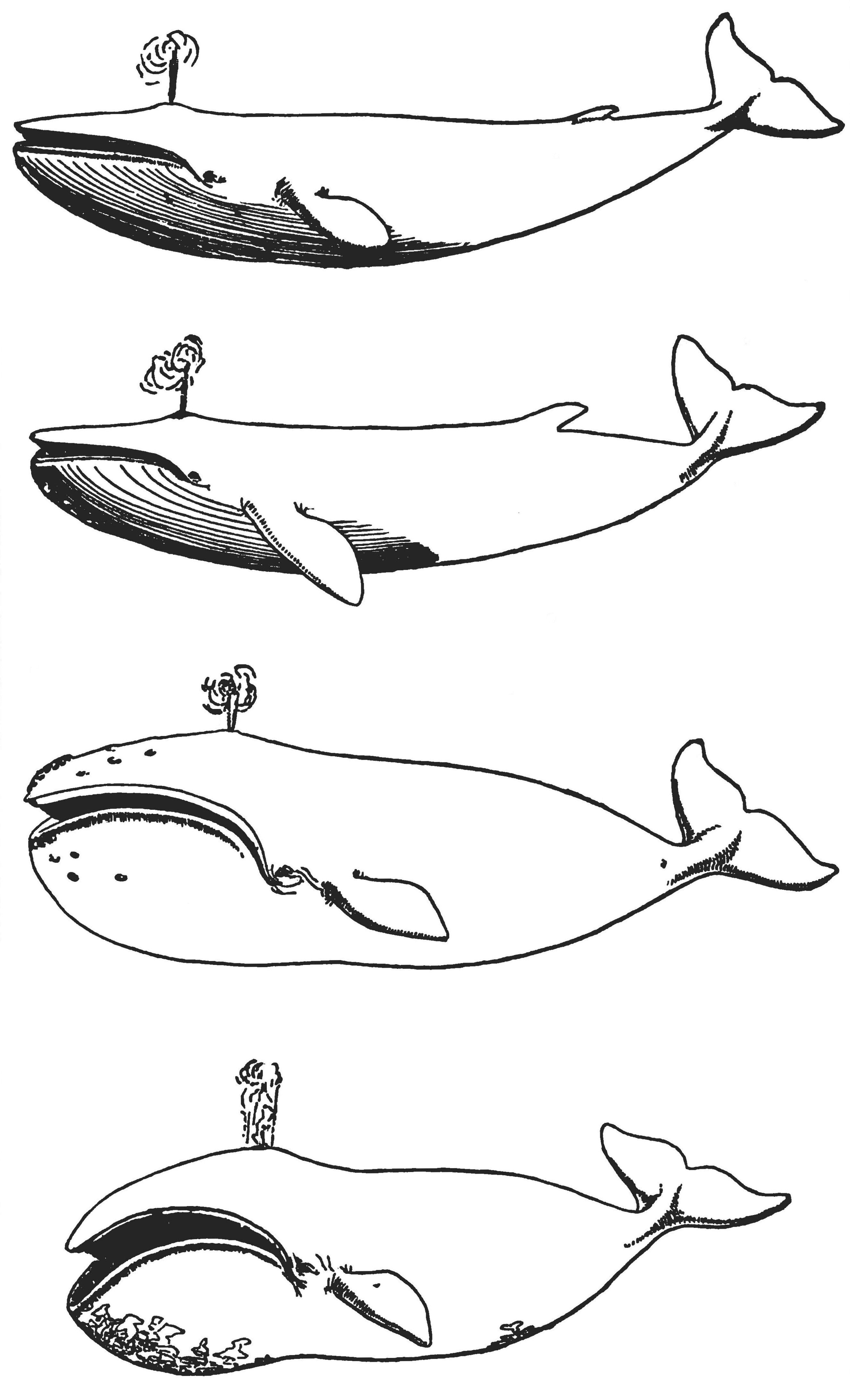
Plate II.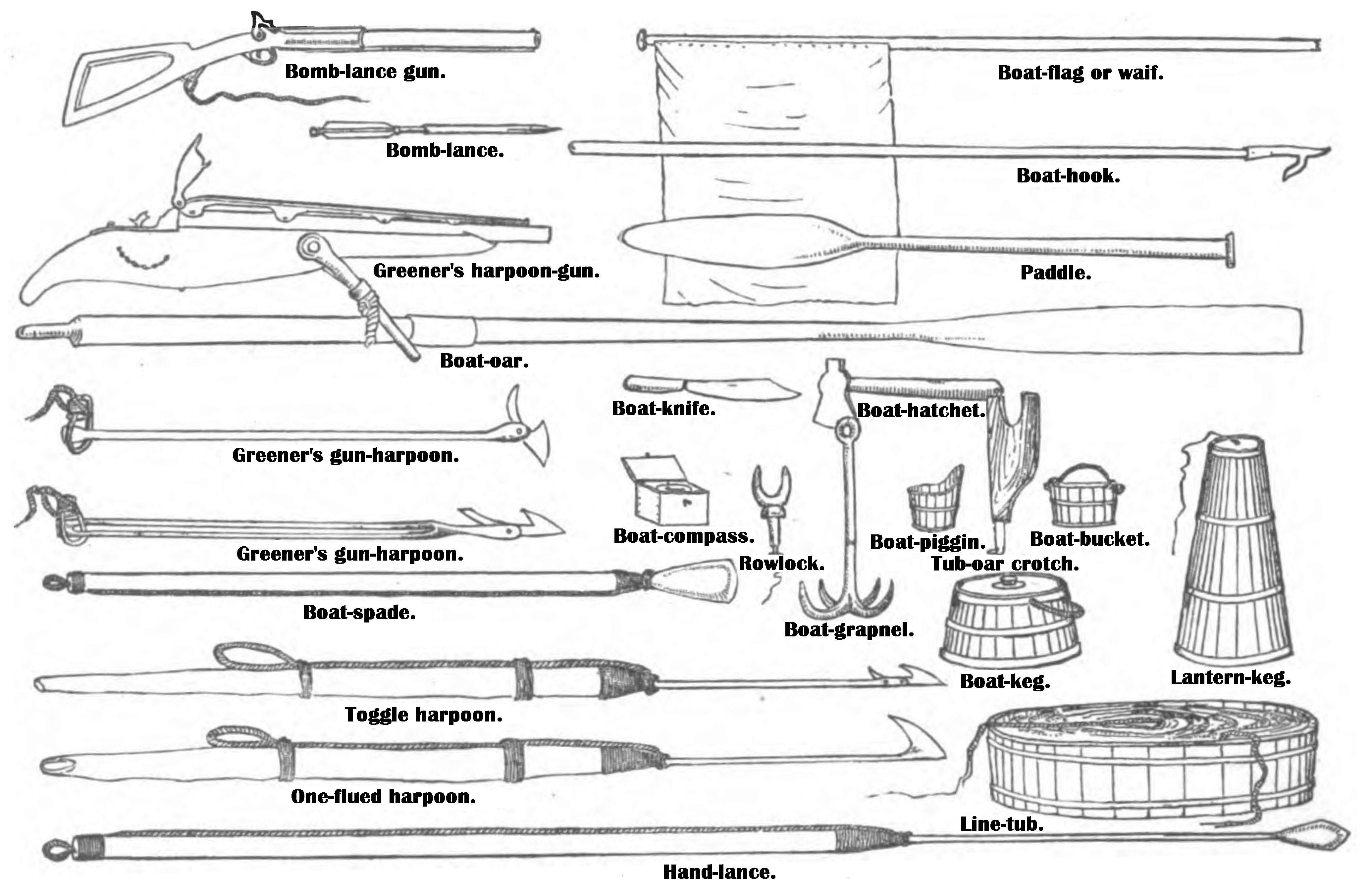
Plate III.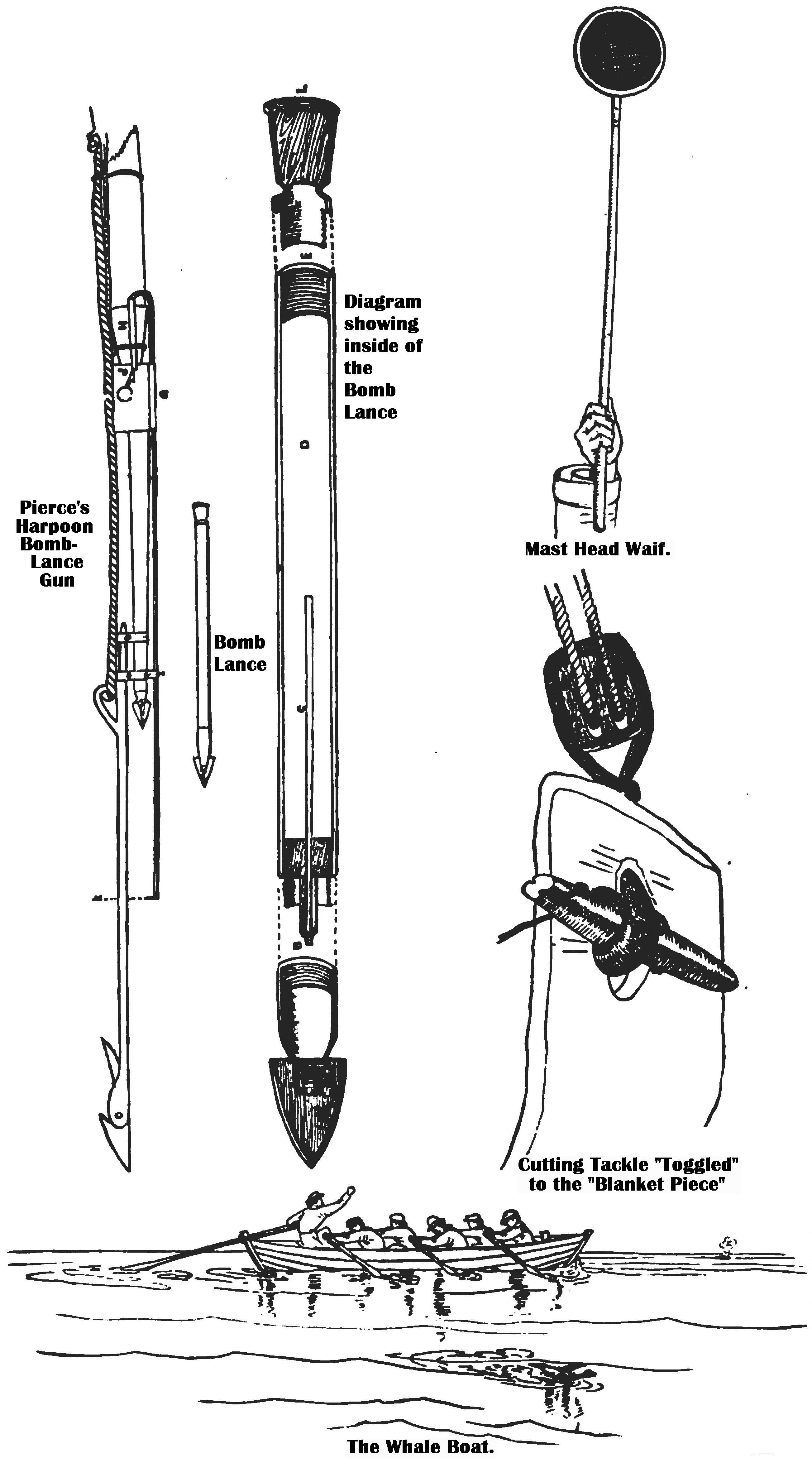
Plate IV.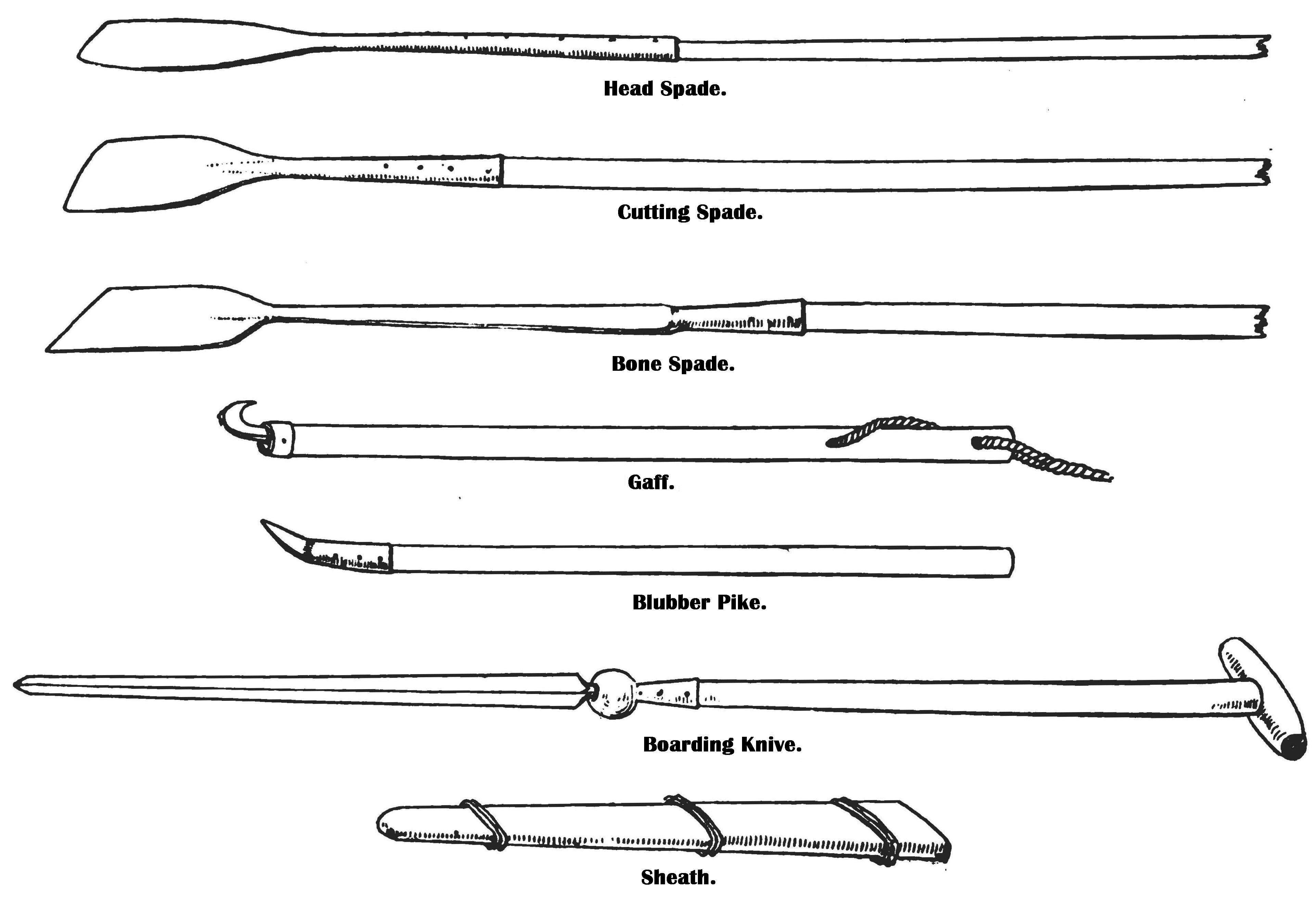
Plate V.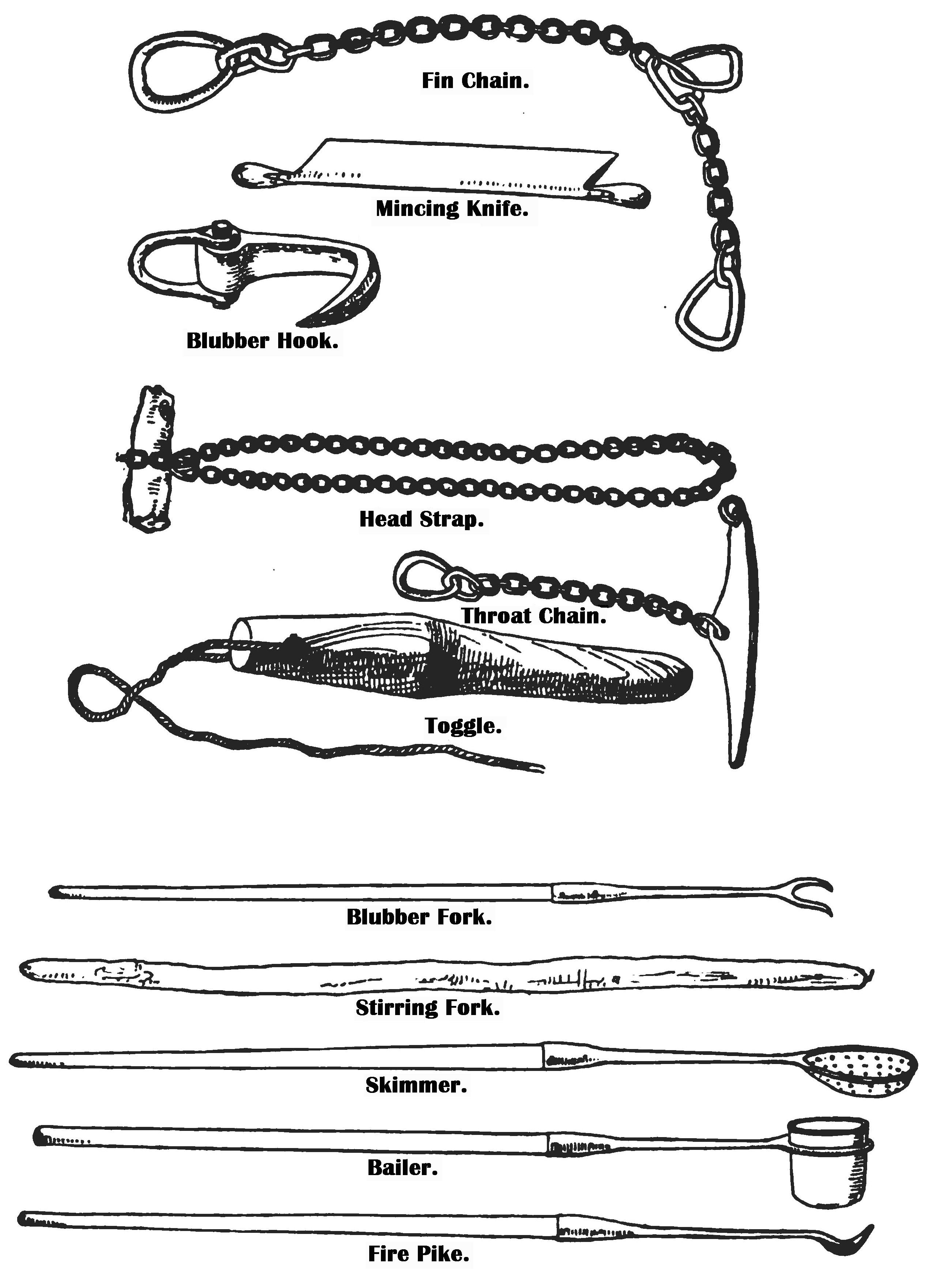
Plate VI.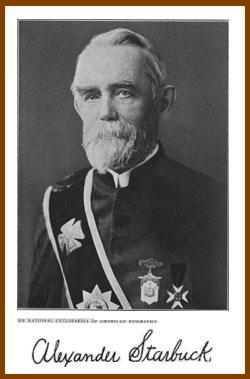
Photograph of Alexander Starbuck. |
Lionel Berners Cholmondeley.The history of the Bonin Islands from the year 1827 to the year 1876, and of Nathaniel Savory, one of the original settlers; to which is added a short supplement dealing with the islands after their occupation by the Japanese.1915. |
List of Illustrations
|
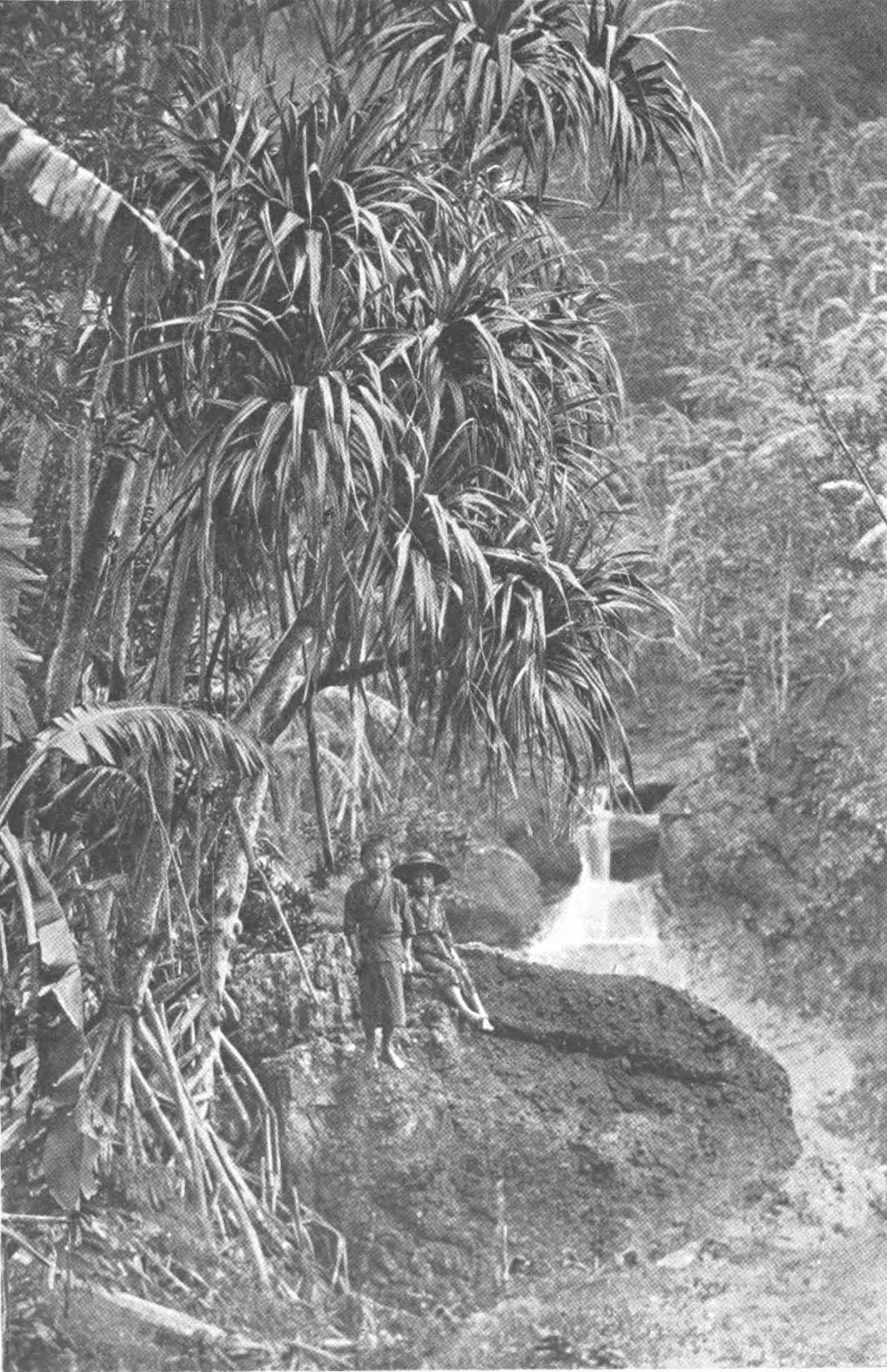
The Lohala Palm.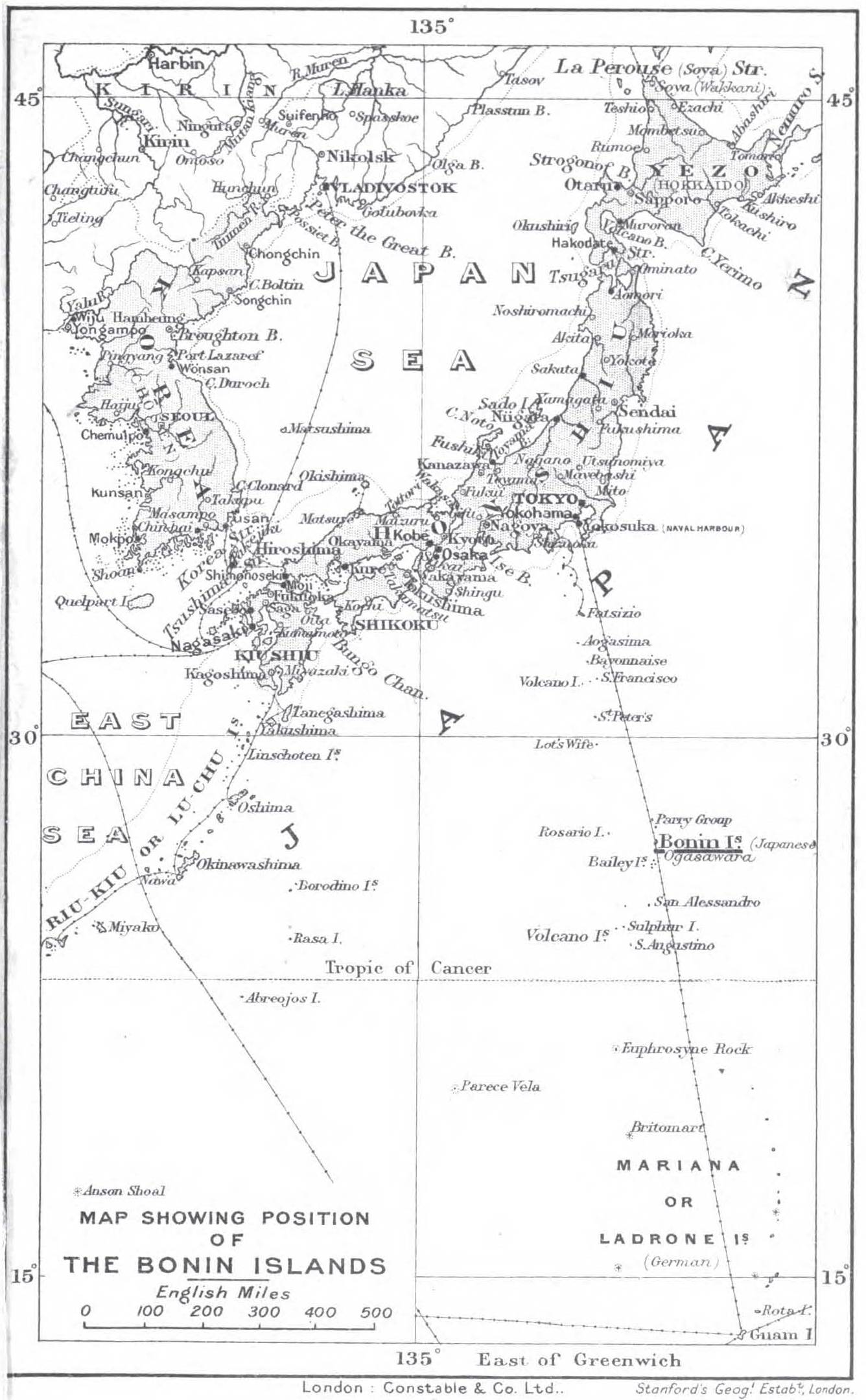
Map Showing Position of the Bonin Islands.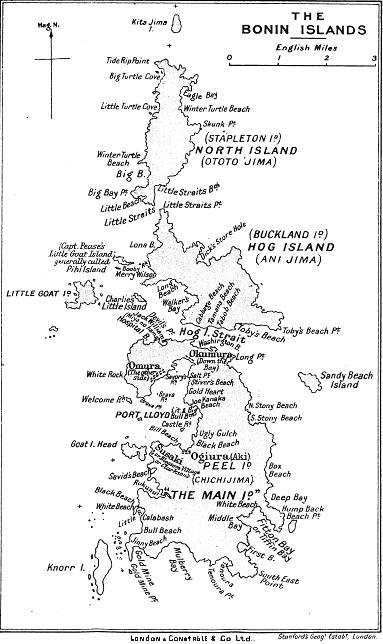
The Bonin Islands.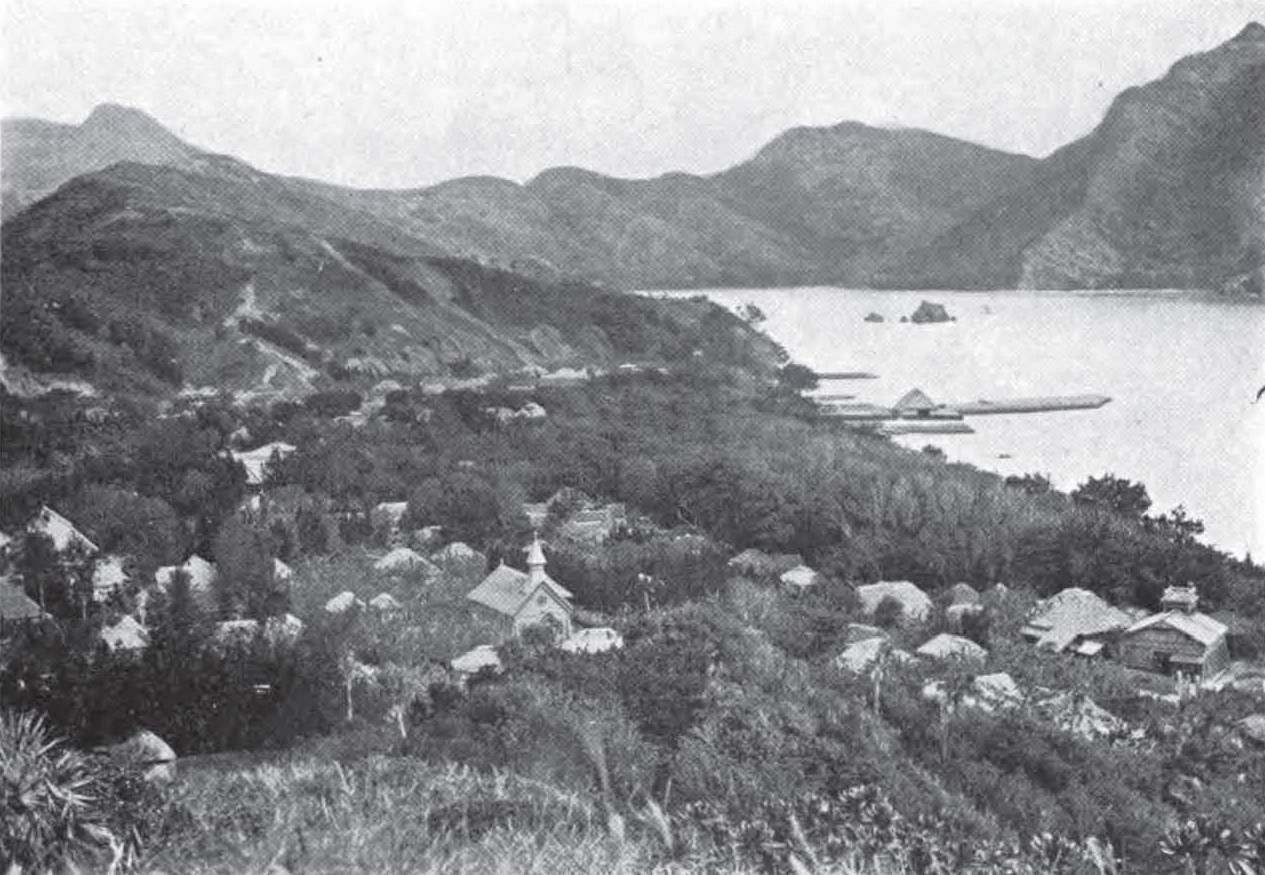
Bonin Islands. The Harbour..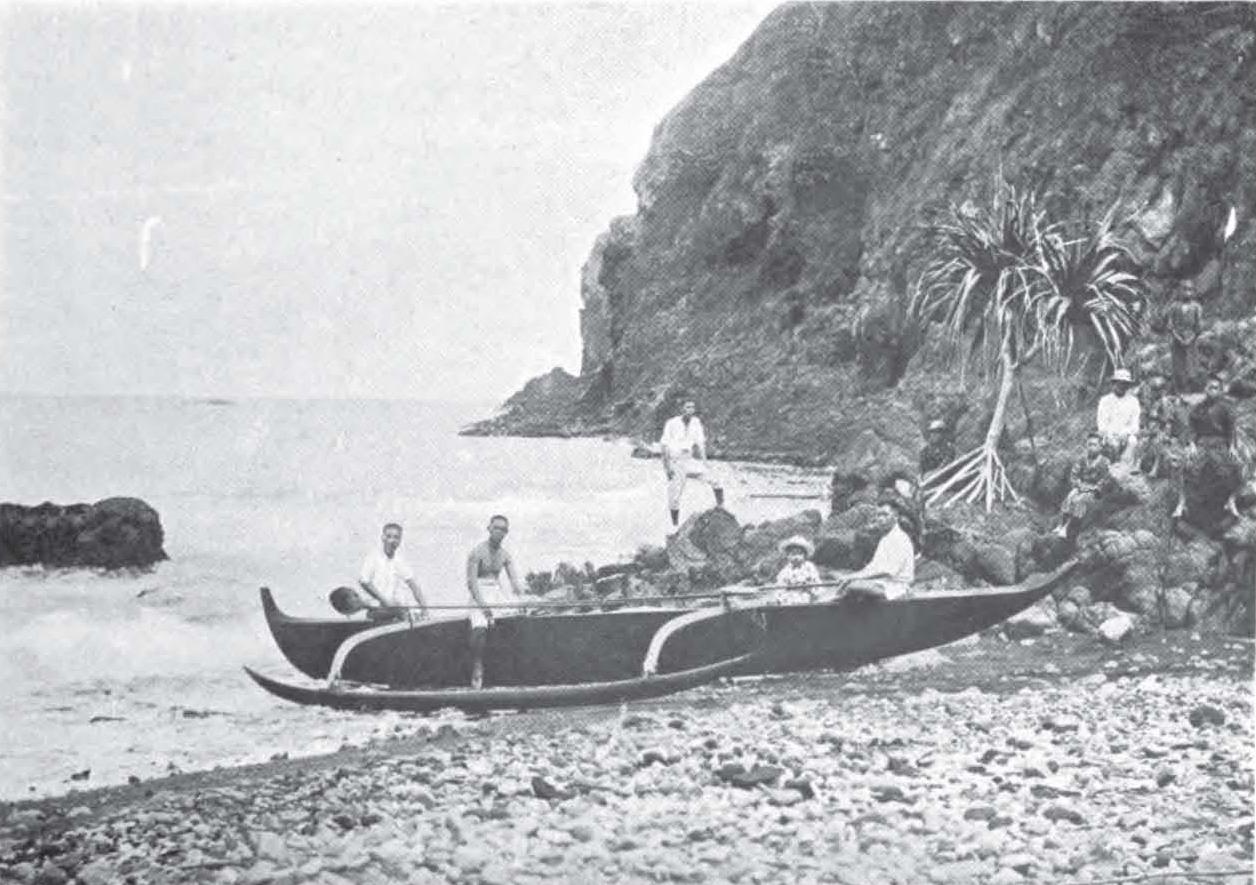
Bonin Islands. A View of the Coast.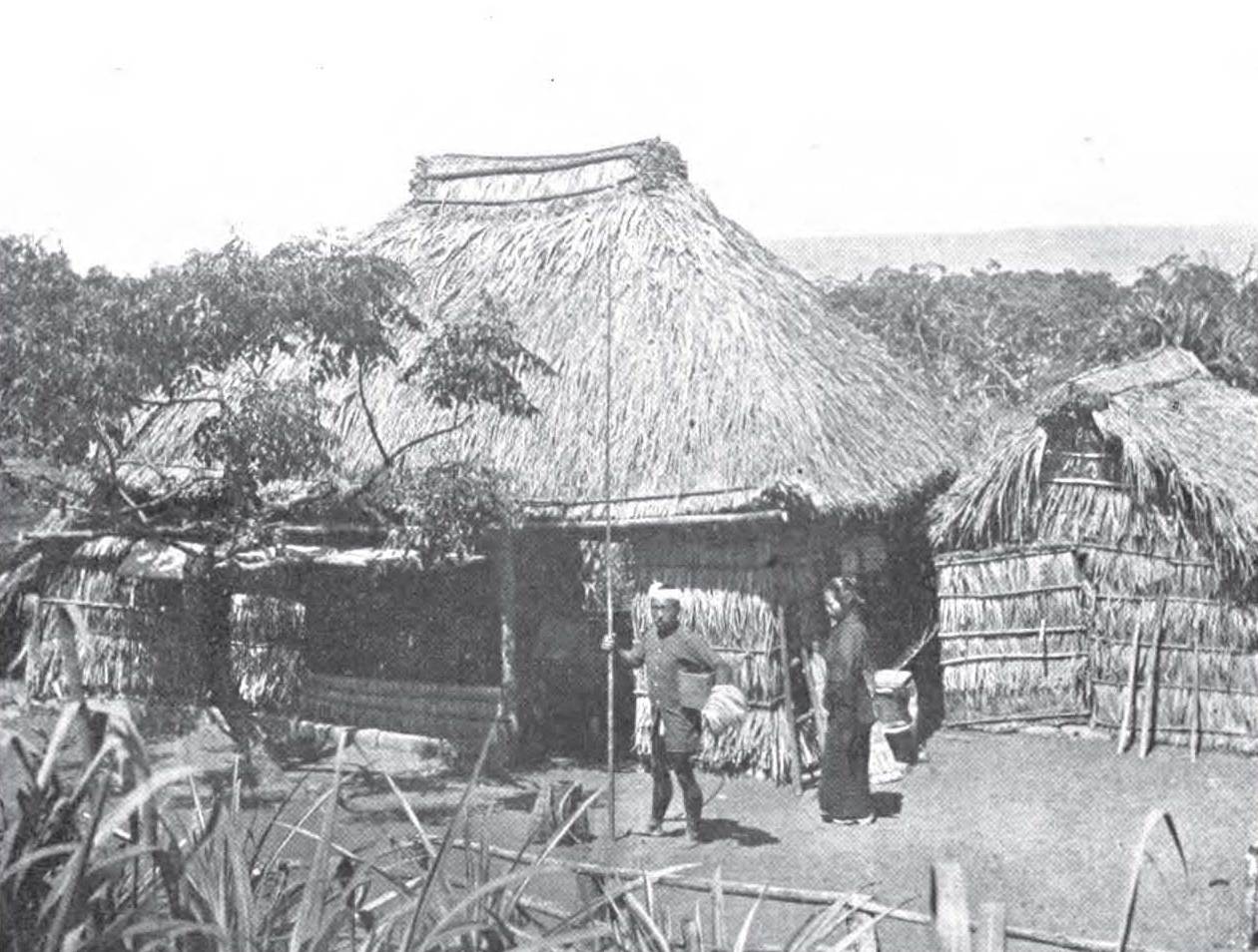
Native's House.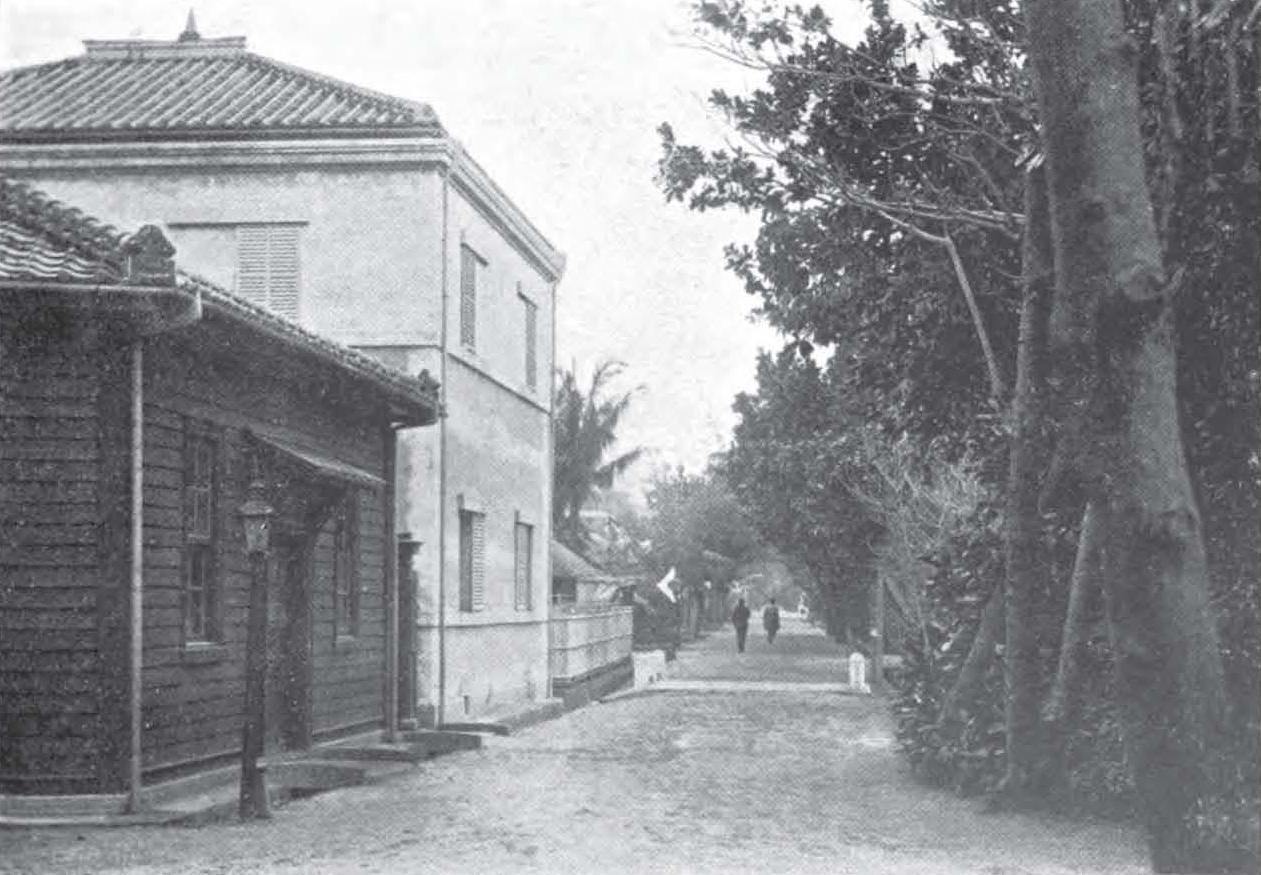
Bonin Island. Post Office and Main Street.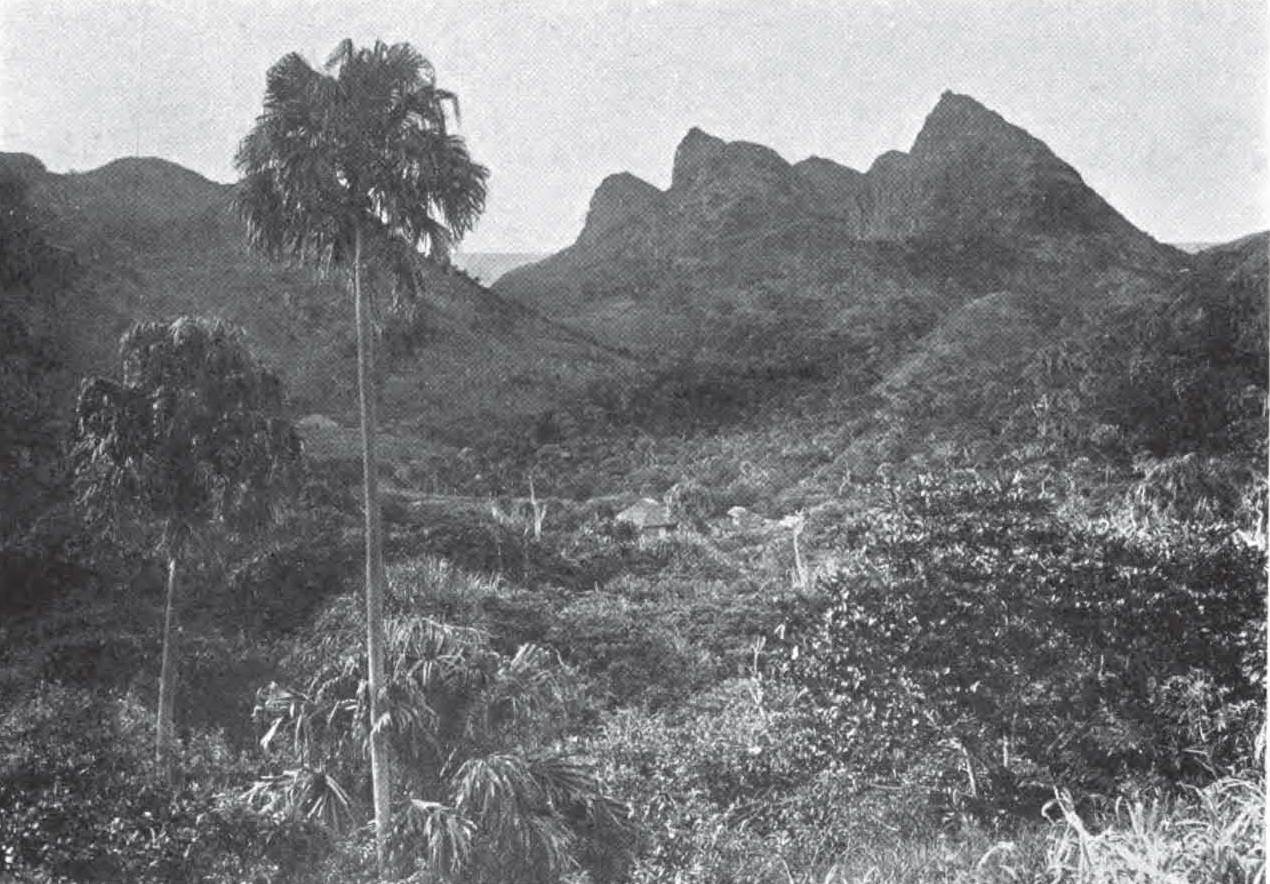
Ototojima (North Island).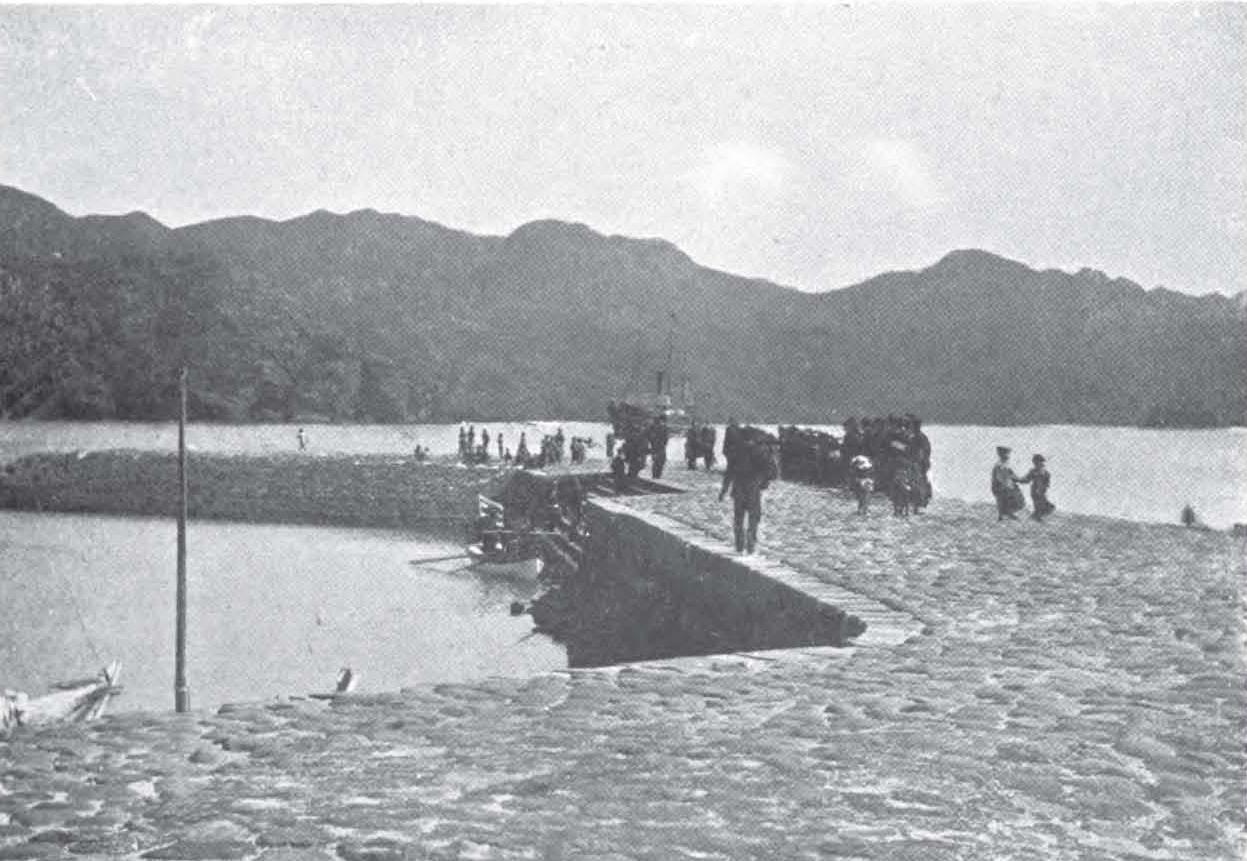
Chichijima. The Jetty.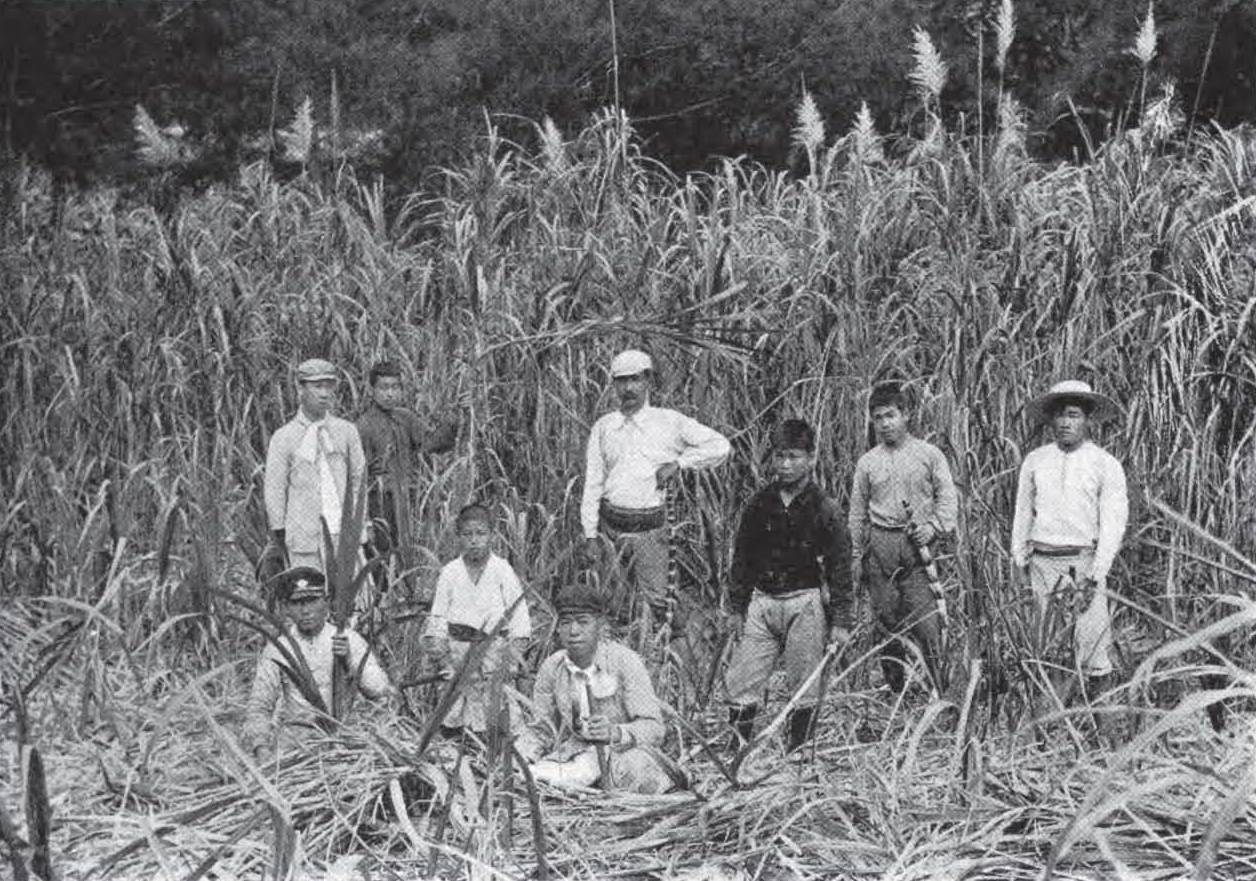 Sugar Cane.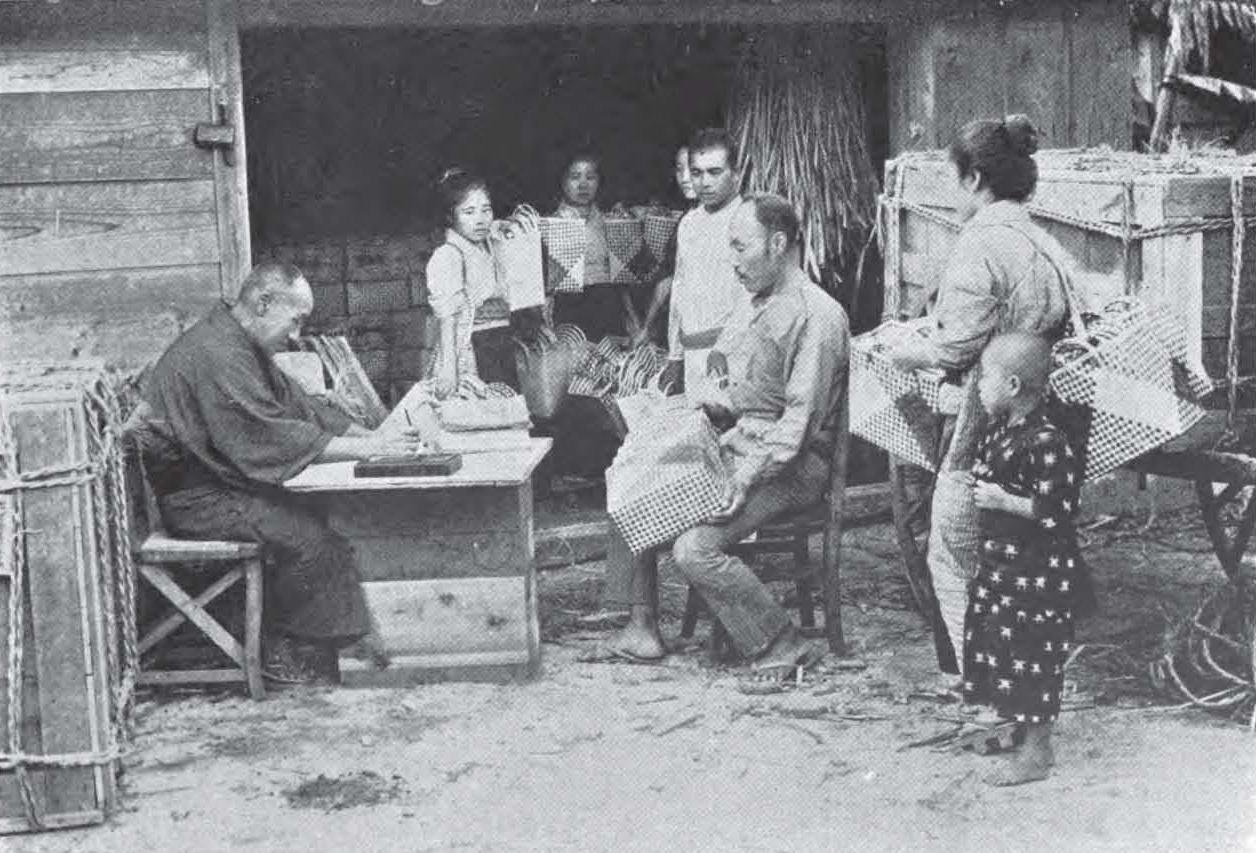 Bonin Baskets.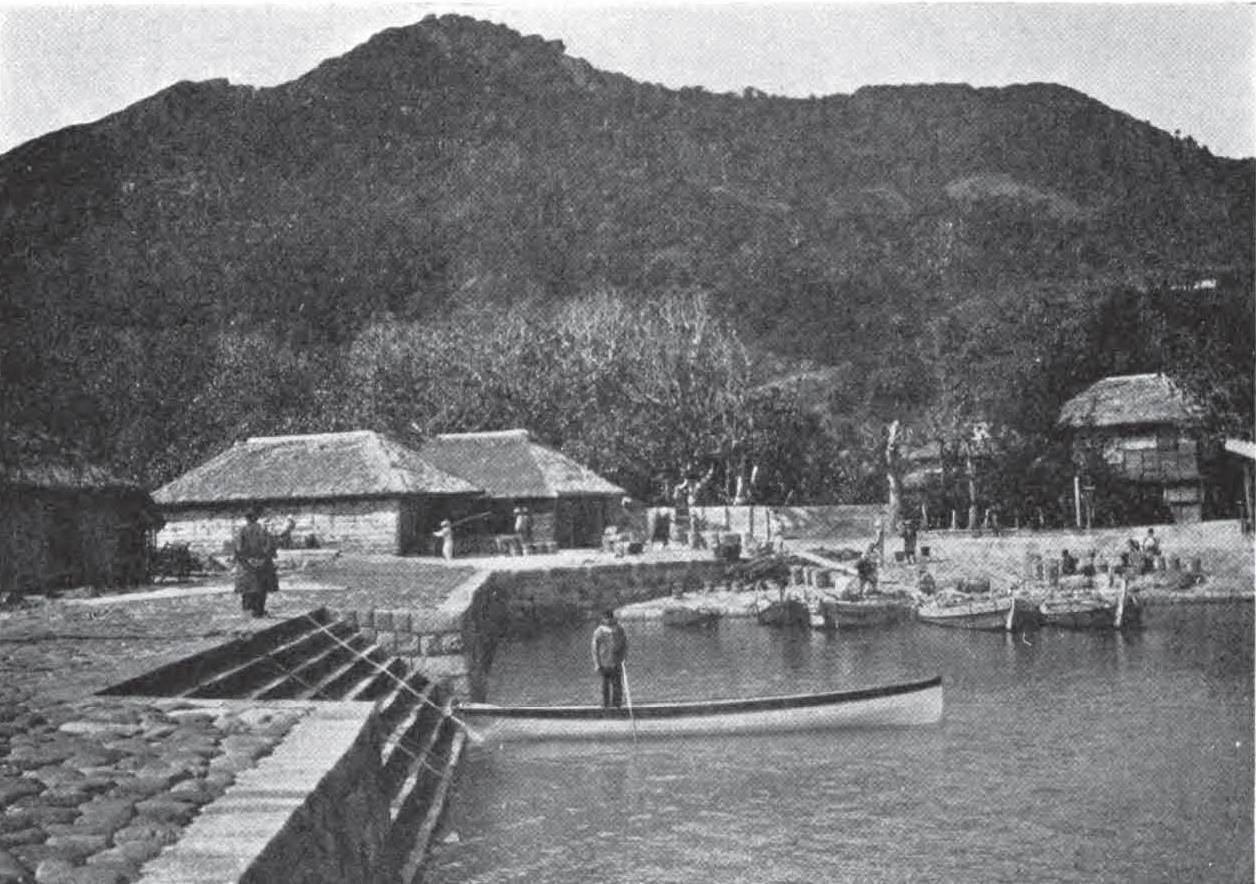
Chichijima. Landing Place.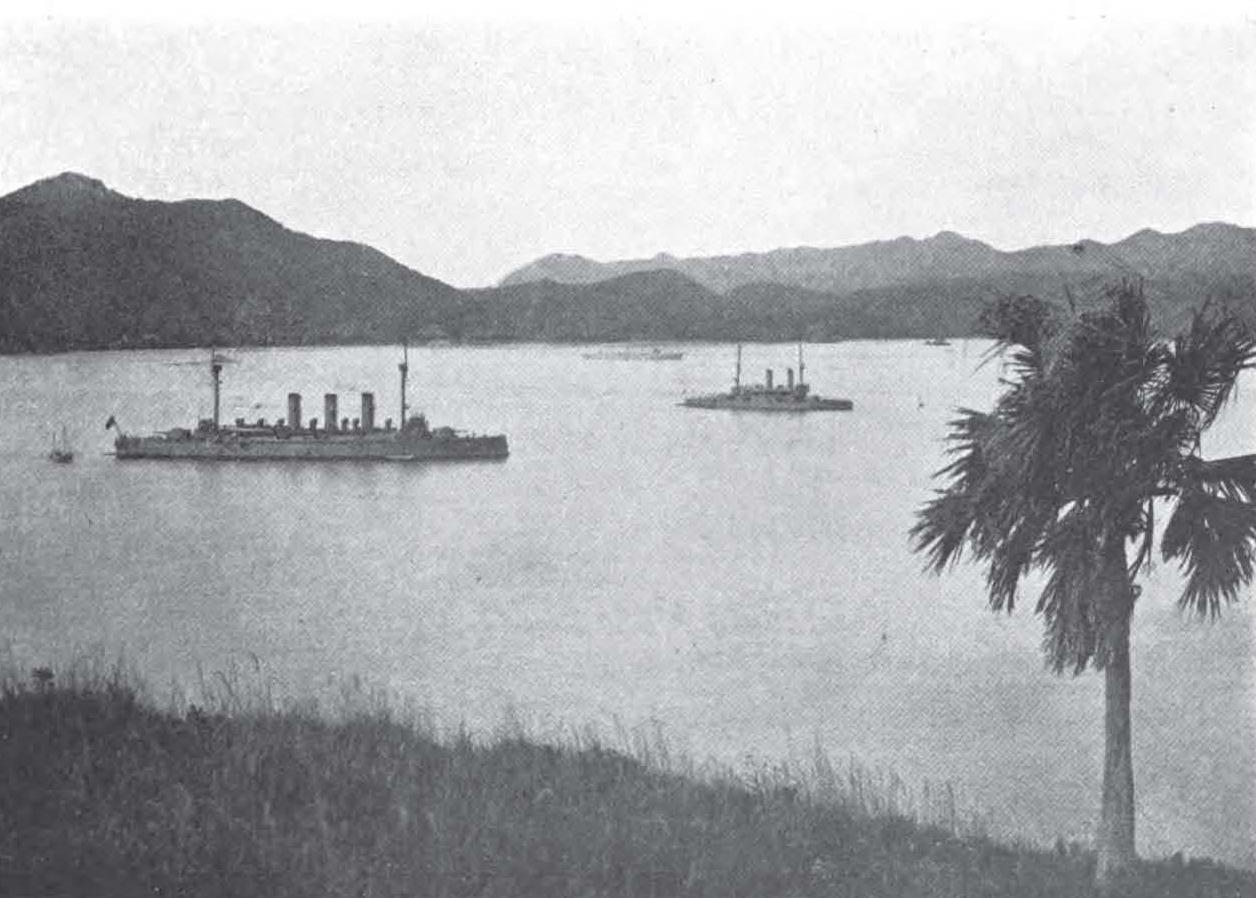
Japanese Men of War in the Bonin Harbour.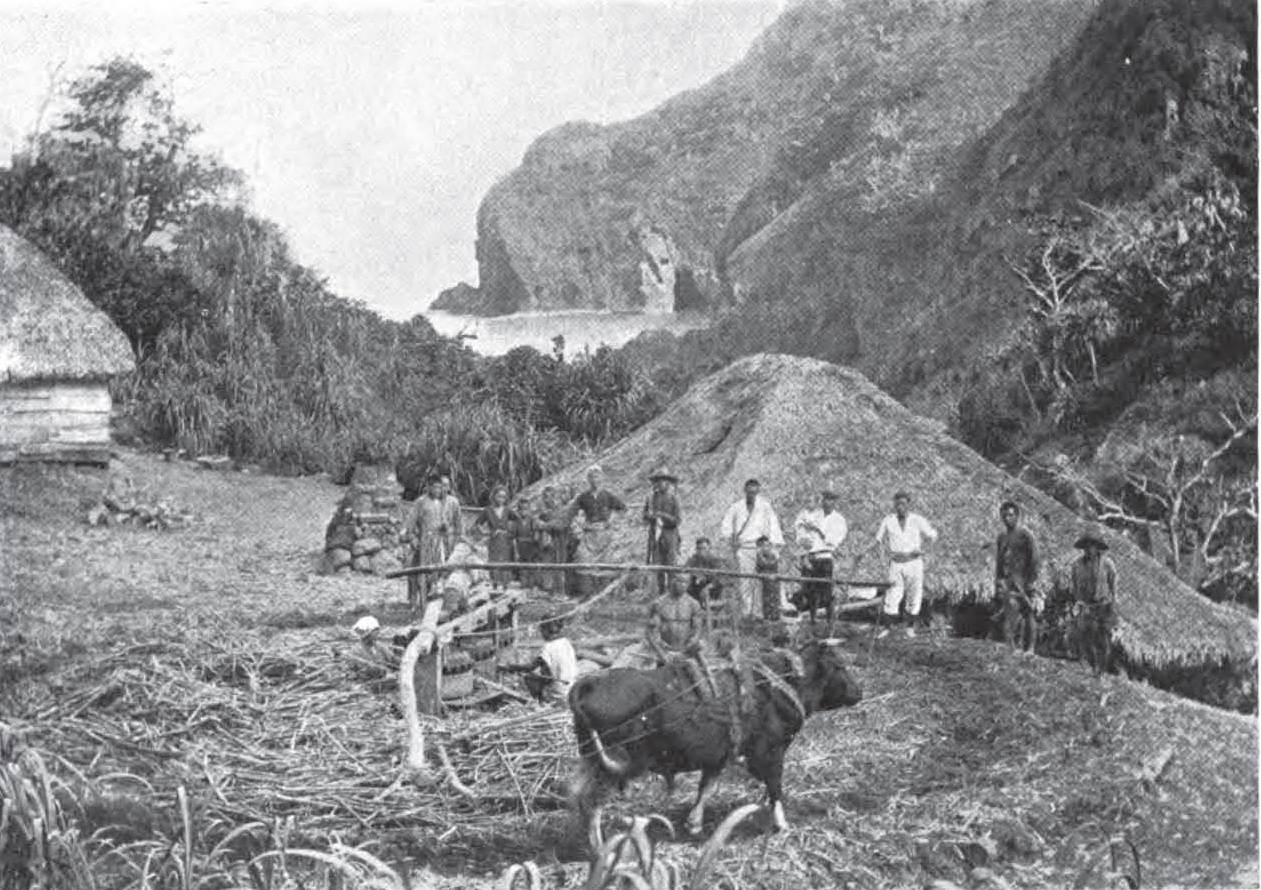
Crushing the Sugar Cane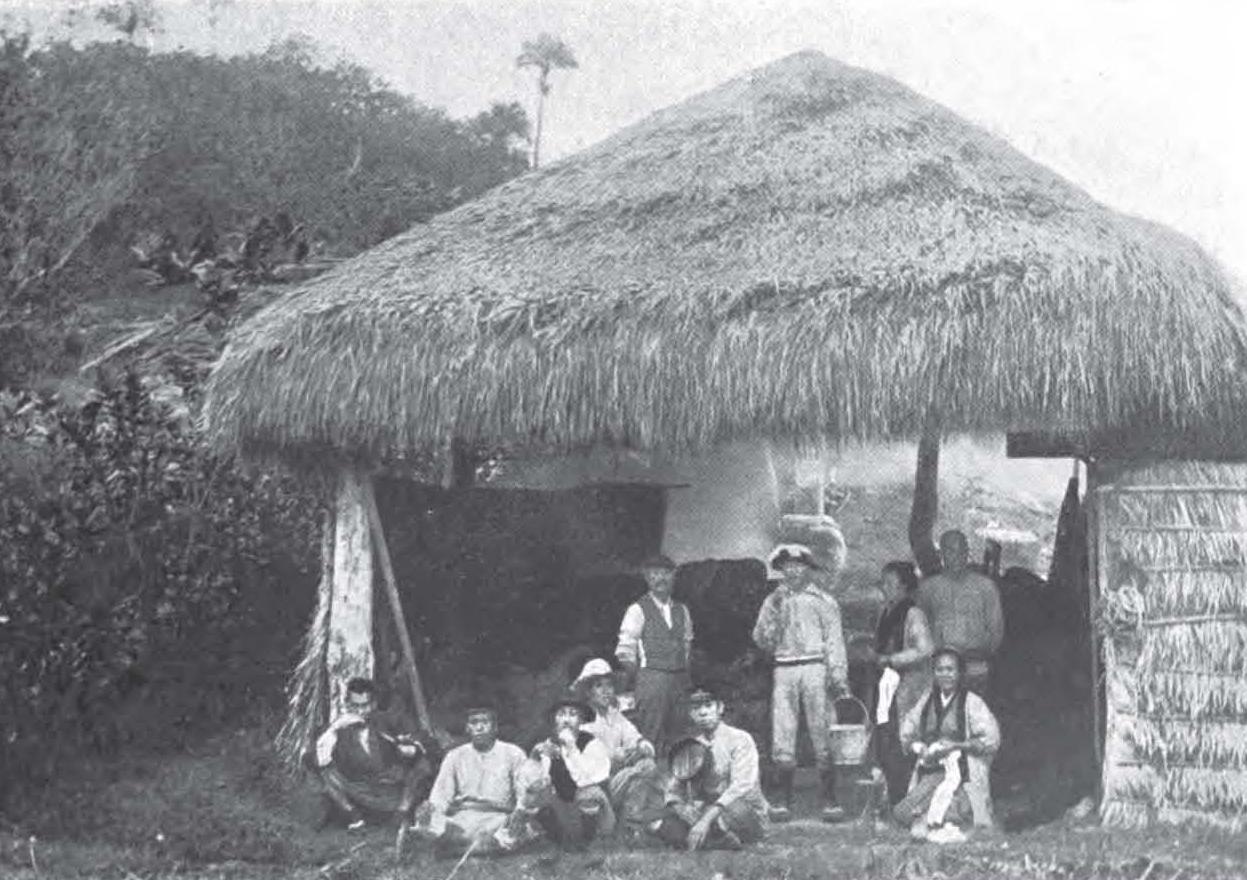
A Sugar Mill Shed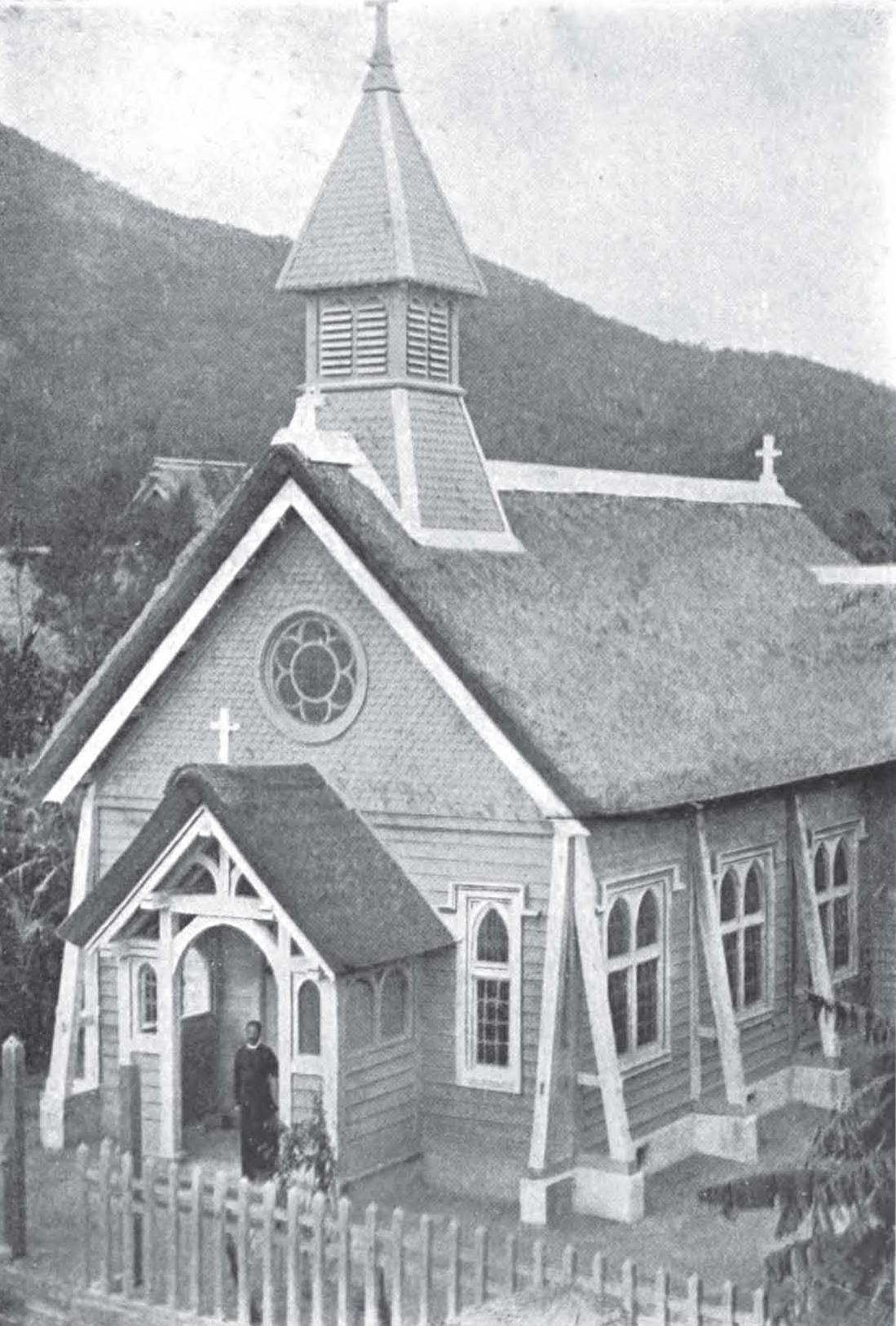
S. George's Church, Bonin Islands. |
Verrill, Alpheus Hyatt, 1871-1954.The Real Story of the Whaler: Whaling, Past and Present.1916. |
LIST OF ILLUSTRATIONS
|
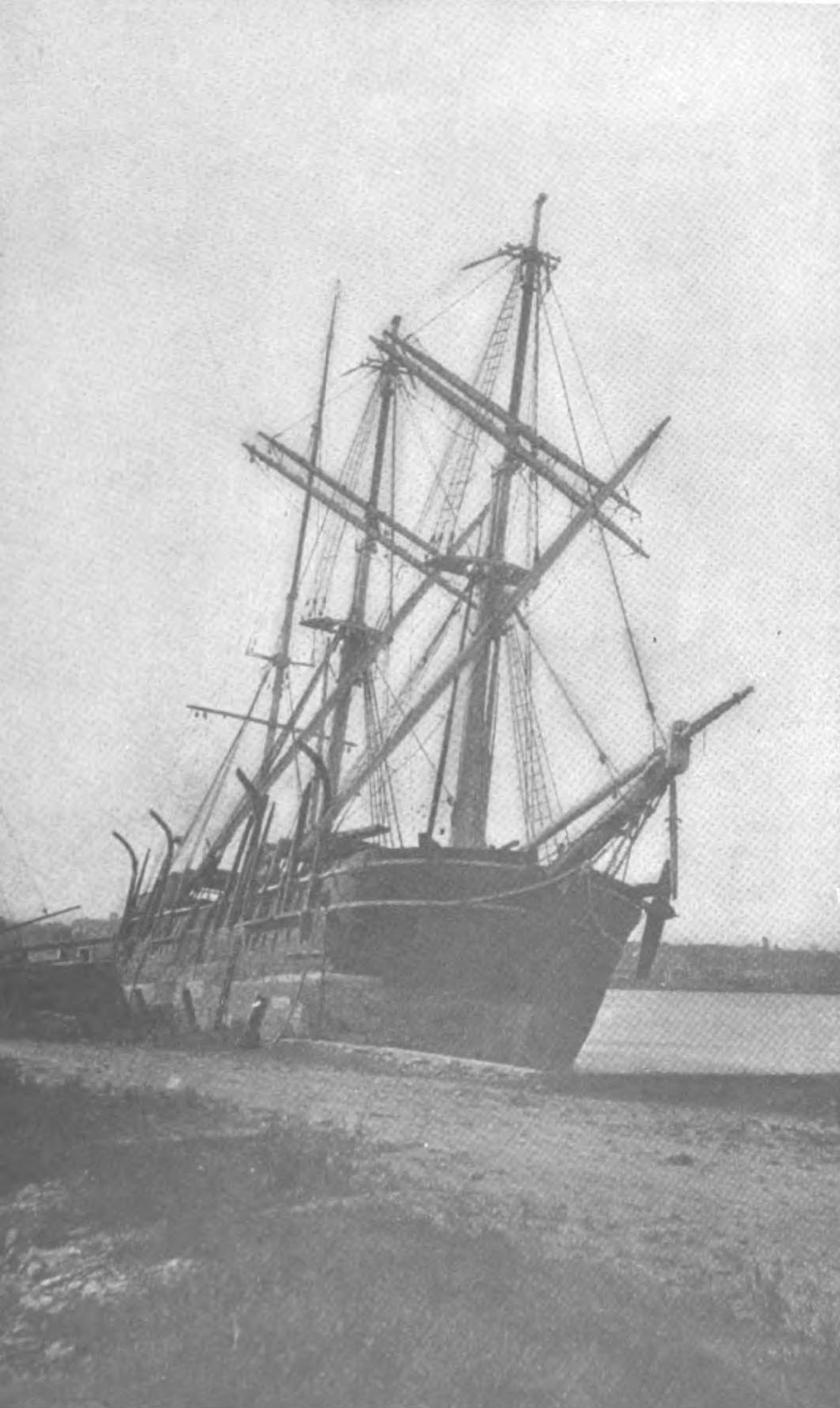
Out of Commission. Bark Charles W. Morgan, Built in 1841.
|
| A – | Gun barrel about 20 inches long. |
| B – | Ordinary iron pole fitted in brass socket c; b. Breechpin and lock-case. |
| C – | Harpoon with whale line e attached, and set in projections d, d on the gun; d. Bomb-lance fired from barrel a. The harpoon upon entering the whale brings the wire rod g in contact with the whale and thus releases the trigger. |
| F – | Lever for cocking the gun. h. Line by which gun is hauled back to boat. |
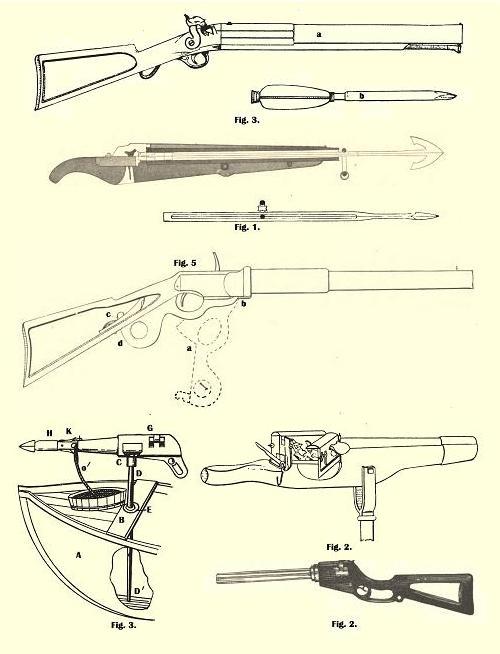

| 1 – | Lower block strapped with rope a, a, a and blubber-hook g shackled into grommet d. The ropes c, c, c, are for handling block easily and the back-lashing h is held by the officer when directing the point of hook into hole in blubber. |
| 2 – | Upper-blocks, b; guy-block, c; pendant-shackles, a, and links. |
| 3 – | Lower-blocks, b strapped with chain d and sister-hooks c into which tail may be coupled by means of link e. |
| 4 – | Cutting-tackle hung from mast. It is guyed out by guy-block and rope c, and end of cutting-falls e are led to windlass. |
| 5 – | Small blubber-hook used in handling blubber on deck. |




| Fig. 1. | Blubber-mincing knife. | Fig. 6. | Throat-chain. | |
| Fig. 2. | Boarding knife. | Fig. 7. | Fin-chain. | |
| Fig. 3. | Monkey-belt. | Fig. 8. | Head-strap. | |
| Fig. 4. | Wooden toggle. | Figs. 9. | Blubber-hooks. | |
| Fig. 5. | Chain strap. |
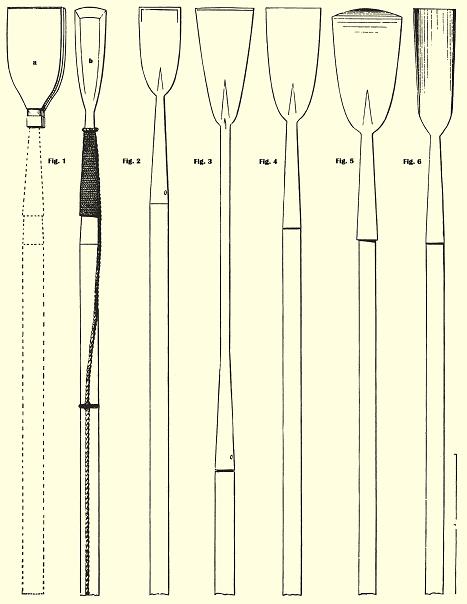
| 1 – | Boat spade b and sheath a used to disable a running whale. |
| 2 – | Narrow cutting-spade or thin boat-spade. |
| 3 – | Flat- or round-shank spade used to cut holes for "head-strap" for hoisting head of bowhead on board and to remove throat bone. |
| 4 – | Cutting-spade for cutting the scarfs in blubber. |
| 5 – | Cutting-spade for "leaning up." |
| 6 – | Half-round spade. |

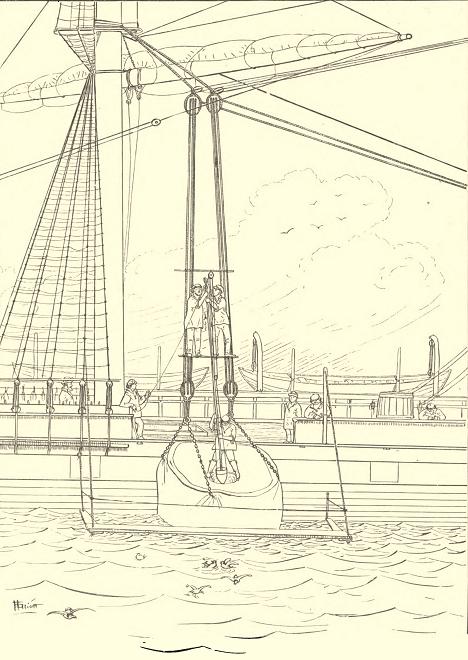
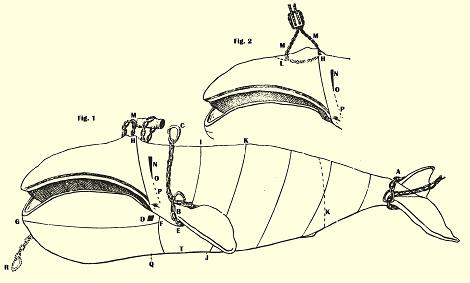
| A – | Fluke-chain adjusted to the "small." |
| B – | Fin-chain fastened around left fin. |
| C – | Ring of fin-chain into which blubber-hook is fastened to raise fin and blanket-piece (the starting point when unwinding blubber from the whale). |
| D – | Hole in root of lip into which blubber-hook is inserted to hoist lip on board ship. |
| F-G – | Scarf to detach and hoist lower lip. |
| E-H – | Scarf cut from fin below and forward of eye to blow-holes H on head. |
| E-I – | Scarf from fin E to back of whale L. |
| J-K – | Scarf cut in removing blubber while whale is being rolled. (The other spiral lines show final scarfs.) L-Hole mortised in head for head-chain. |
| M – | One method of hoisting head by head-chain and `toggles, the chain being passed through the blow-holes. |
| M, M (Fig 2). – | Newer and better method of hoisting head by use of chain strapped blocks. Tail of chain passed through from H, under several feet of blubber to and through the hole cut at L and then coupled to sister-hooks on the lower block. |
| N – | Cutting made by man with an ax (while overboard) in order to detach the head bone. |
| 0 – | Lower edge of bone which is very thin and requires only light strokes to free it. |
| P – | Markings showing where the spade is inserted to start the throat bone in detaching head. |
| Q – | Where the hole is made in throat in order to haul it on board. |
| R – | Throat-chain and toggle by which throat is sometimes taken on board. |
| S – | Dotted line to show where backbone is cut to lessen strain on windlass when taking off blubber. |
| T – | Wide section of blanket-piece which is trimmed down by boarding-knife when taking blubber on board. |
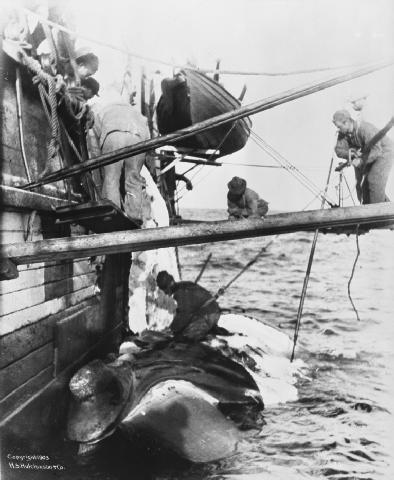
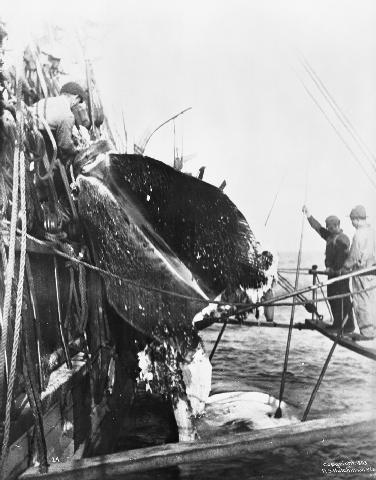
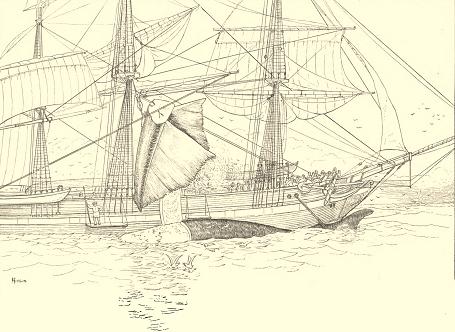
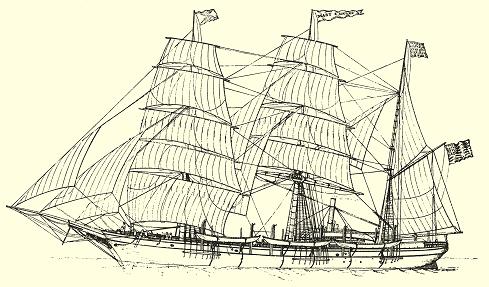

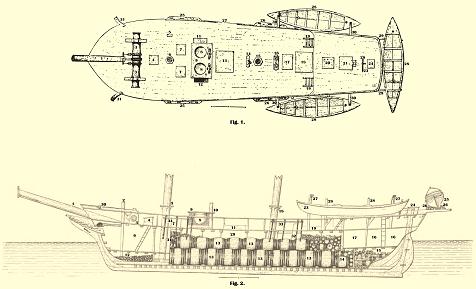
| Deck: | 1 – Bowsprit-heel. 3 – Windlass and bitts. 4 – Forecastle companionway. 5 – Fluke-chain bit. 6 – Foremast. 7 – Cable-boxes. 8 – Try-pots. 9 – Try-works. 10 – Chimneys or try-work pipes. 11 – Cooler. 12 – Scrap-hopper. 13 – Main hatch. 14 – Foresheet block. 15 – Mainmast. 16 – Pumps. 17 – After hatch. 18 – Galley. 19 – Deck steps. 20 – Cabin skylight. 21 – Cabin companion. 22 – Binnacle. 23 – Wheel. 24 – Cutting-in gangway. 25 – Fore channels. 26 – Main Channels. 27 – Cutting-in gangway. 28 – Boats. 29 – Skids for spare boats. 30 – Boat davits. 31 – Cat-heads. |
| Section: | 1 – Bowsprit. 2 – Paul-bitt. 3 – Windlass. 4 – Forecastle companionway. 5 – Foremast. 6 – Forecastle. 7 – Chain-cable box. 8 – Try-pots. 9 – Try-works. 10 – Chimney. 11 – Main hatch. 12 – Coal-locker. 13 – Casks for oil. 14 – Ship stores, gear, etc. 15 – Captain's storeroom. 16 – Cabin. 17 – Steerage. 18 – Mainmast. 19 – After hatch. 20 – Galley. 21 – Cabin skylight. 22 – Cabin companion. 23 – Whaleboat. 24 – Steering gear. 25 – Stern boat. 26 – Spare oars, spars, etc. 27 – Boat-davits. 28 – Boat-bearers. 29 – Main hold. 30 – Catheads. 31 – Cutting-blocks, gear, etc. 32 – Pumps. 33 – Main channels. 34 – Fore channels. |
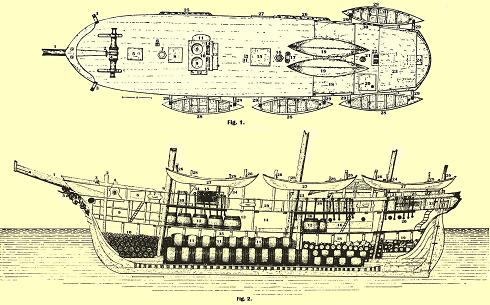
| Deck: | 1 – Bowsprit-heel. 2 – Pawl-bitt. 3 – Catheads. 4 – Windlass. 5 – Forecastle companion. 6 – Fluke-chain bitt. 7 – Foremast. 8 – Fore hatch. 9 – Trypots. 10 – Try-works. 11 – Cooler. 12 – Scrap-hopper. 13 – Work-bench. 14 – Chimney. 15 – Main hatch. 16 – Mainmast. 17 – Pumps. 18 – Deck-house. 19 – Spare boats. 20 – Galley. 21 – Mizzen-mast. 22 – Cabin skylight. 23 – After deckhouse. 24 – Wheel. 25, 26 – Channels. 27 – Cutting-in gangway. 28 – Whaleboats. 29 – Davits. 30 – Mizzen chains. 31 – Bit for belly-chain on whale. |
| Interior: | 1 – Bowsprit. 2 – Pawl-bitt. 3 – Cathead. 4 – Windlass. 5 – Figure-head. 6 – Forecastle companion. 7 – Hawse-chocks. 8 – Foremast. 9 – Forecastle. 10 – Forehold with shooks, gear, etc. 11 – Casks for oil. 12 – Casks for oil. 13 – Fore 'tween decks. 14 – Blubber-room. 15 – Try-works. 16 – Steerage. 17 – Chain-locker and pumps. 18 – After hold with stores, gear, etc. 19 – Captain's stores, etc. 20 – Captain's cabin. 21 – Galley. 22 – Skids for spare boats. 23 – Mainmast. 24 – Mizzen-mast. 25 – After-house. 26 – Boat-davits. 27 – Whaleboats. 28 – Boat-bearers. 29 – Main hatch. 30 – Fore hatch. 31 – Booby hatch. 32 – Cabin skylight. 33 – Wheel. 34 – Boat-cranes. 35 – Lower main hold. 36 – After 'tween decks. |
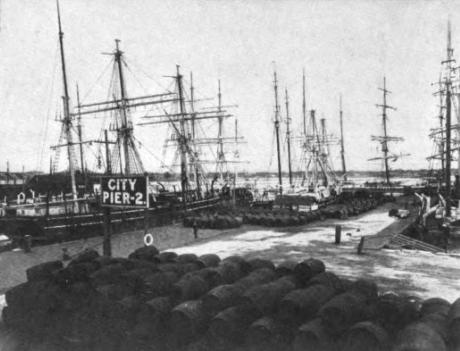
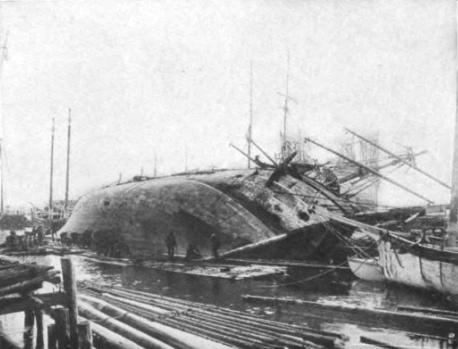
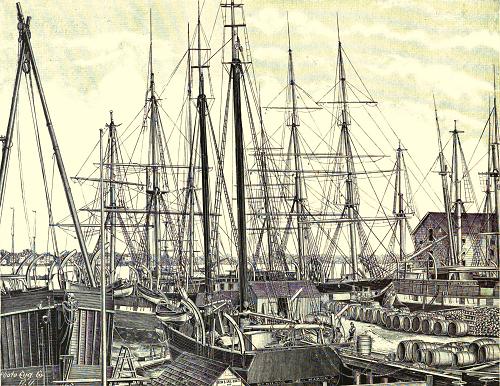
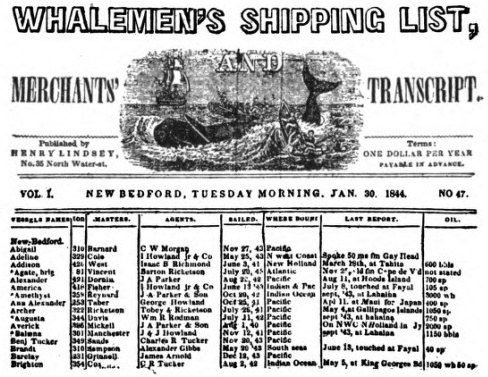
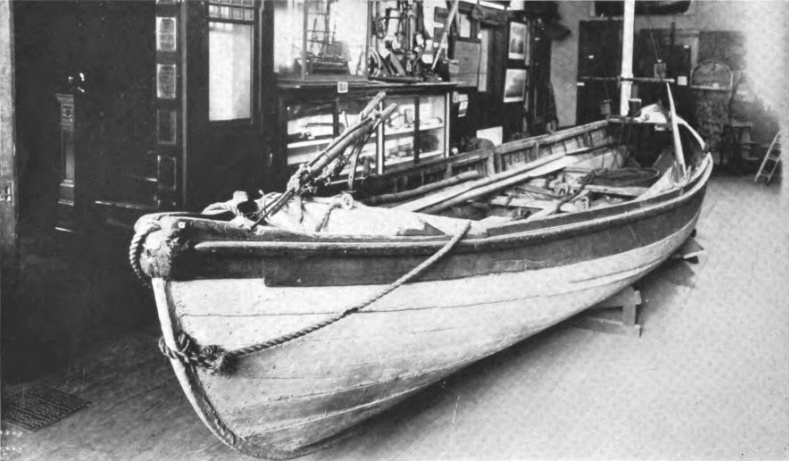


A, First iron resting in bow-chocks with handle in boat-crotch.
B, Second iron.
C, c, Spare irons.
D, D, D, Hand lances.
E, Boat spade.
F, G, Harpooner's oar.
H, Bow-oar.
I, Mid-ship oar.
J, Tub-oar.
K, Stroke-oar.
L, Steering-oar.
M, M, M, Paddles.
N, Small tub and line.
O, Large tub and line.
P, P, P, Tow-line extending aft from large tub around loggerhead and forward across thwarts to box of boat (4) where it is coiled and known as "box-warp" (P, P) thence extending to eye-splice of first iron.
Q, Q, Mast and sail.
R, Steering-oar-brace.
S, Lashing or strap for handle of steering-oar when not in use or fast to a whale.

1 – Lantern keg containing matches, bread, tobacco, etc. 2 – Compass. 3 – Fresh-water keg. 4 – Piggin for bailing. 5 – Waif. 6 – Tub-oar crotch (this ships through cleat in gunwale to clear oar from line when fast to a whale). 7 – Double oarlock used as last. 8 – Large tub and line. 9 – Knife for cutting line when necessary. 10 – Rowlock. 11 – Hatchet. 12 – Grapnel. 13 – Drag. 14 – Canvas nipper to protect hands when hauling line.

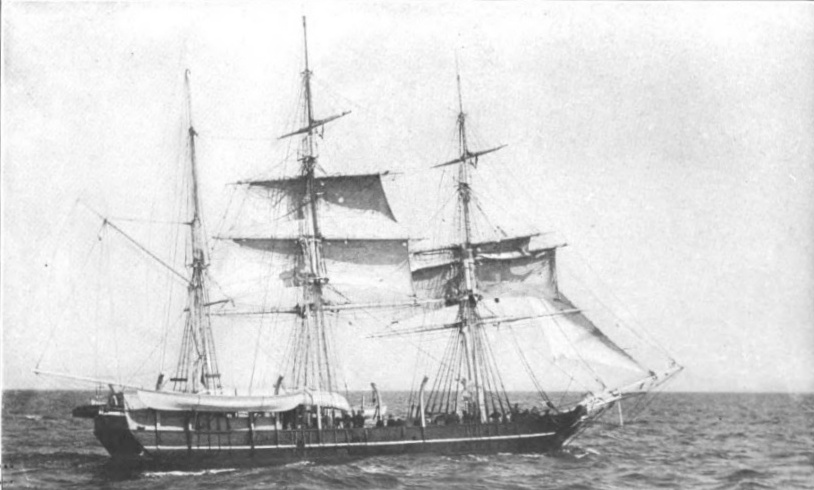
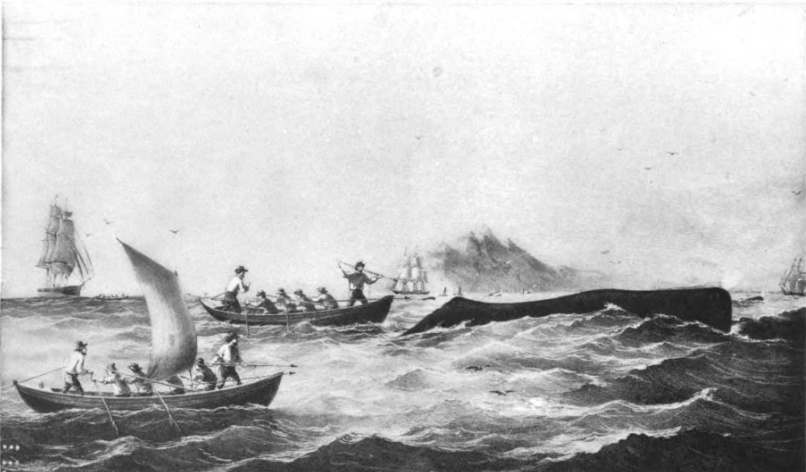
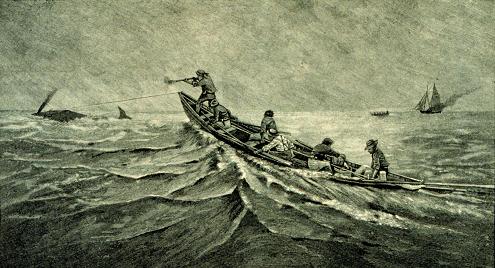
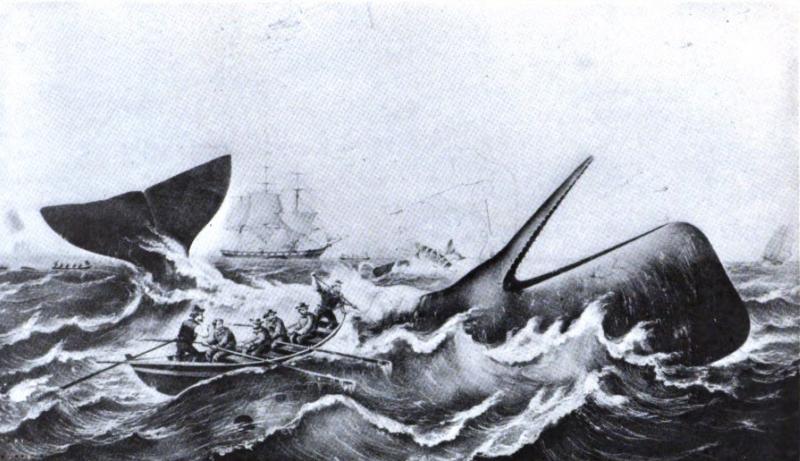

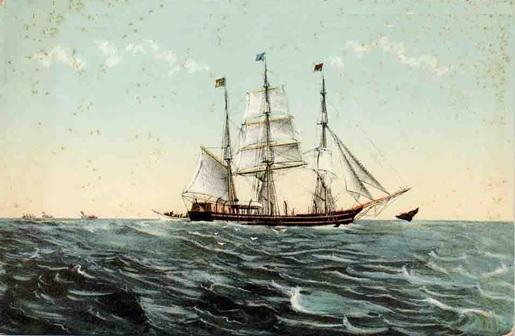
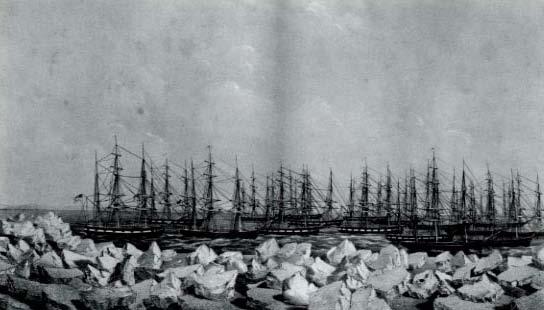
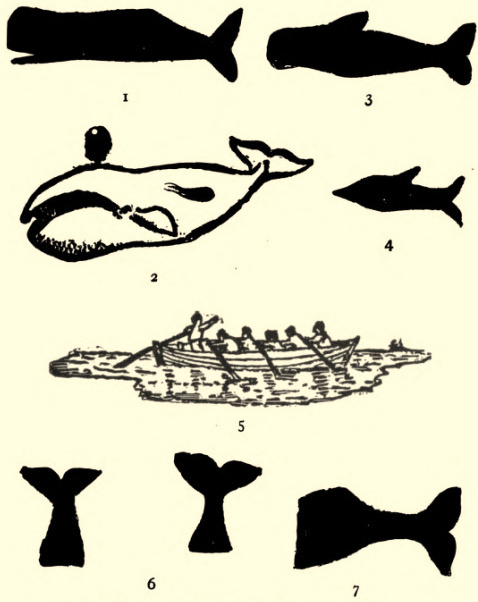

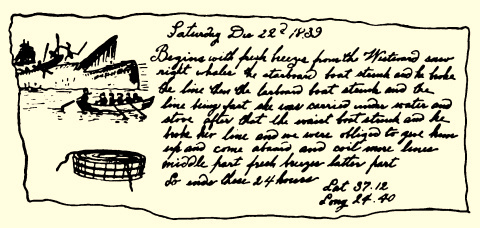
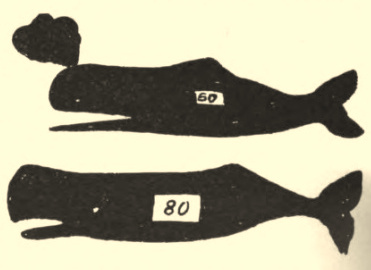
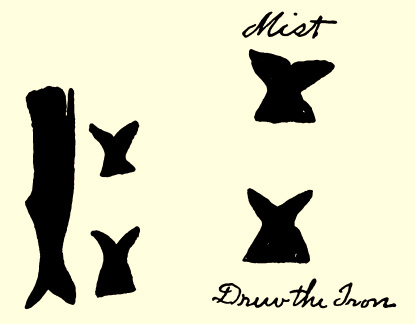
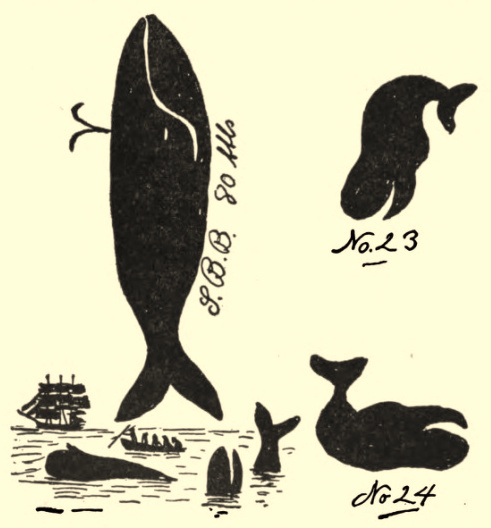



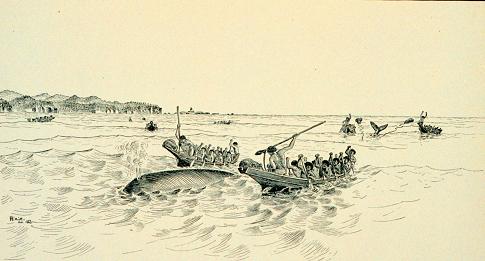
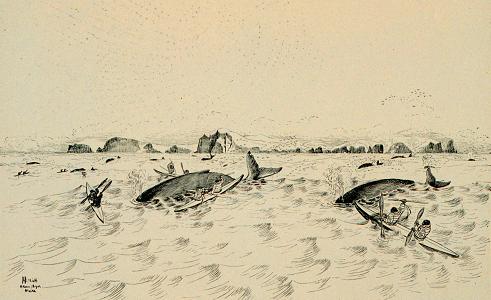

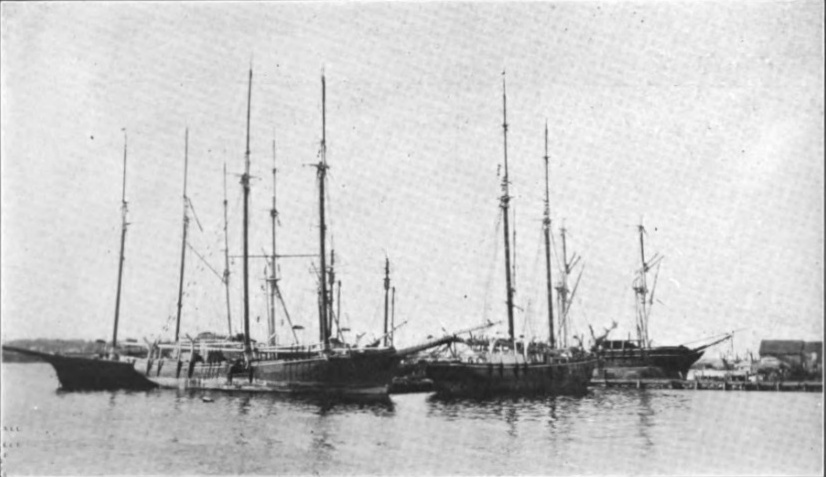

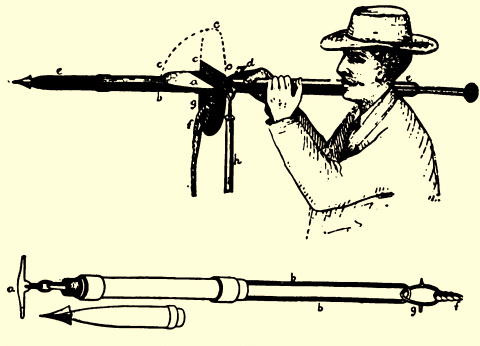


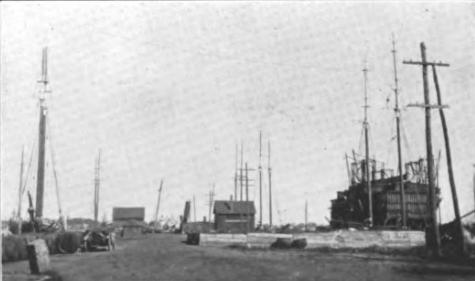

Charles Haskins Townsend.The Galapagos tortoises in their relation to the whaling industry.[1925] |
Illustrations.
|
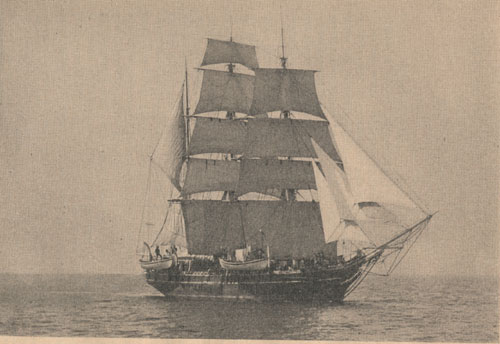
Fig. 20. Bark Morning Star of New Bedford. At Albemarle Island, Galapagos, July 27 to August 5, 1858. At Chatham Island, Galapagos from June 27 to July 11, 1861. Total catch of tortoises, 212. Built at Dartmouth in 1853. 305 tons. Returned from last voyage in 1914. Crew on first voyage all Americans, on last voyage all Portuguese. Photograph by W.H. Tripp, 1914.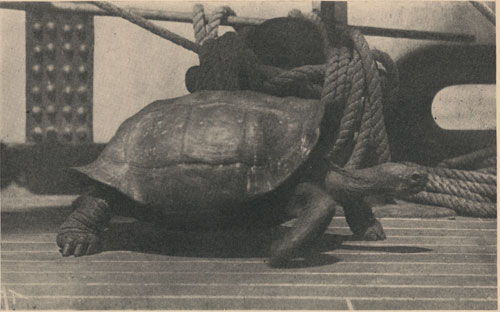
Fig. 21. A Galapagos Tortoise (Testudo ephippium), on the U.S.S. Albatross. Found on Duncan Island in 1891 by C.H. Townsend. Now in the U.S. National Museum. Photograph by C.H. Townsend.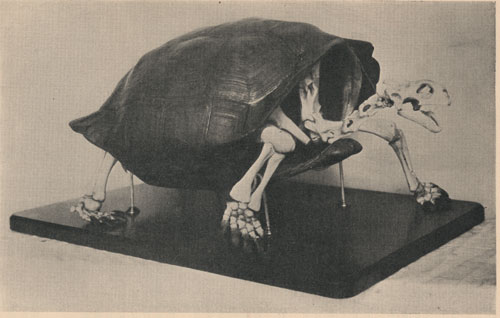
Fig. 22. Skeleton of Duncan Island tortoise (Testudo ephippium), as mounted in the U.S. National Museum. Collected in 1891 by C.H. Townsend.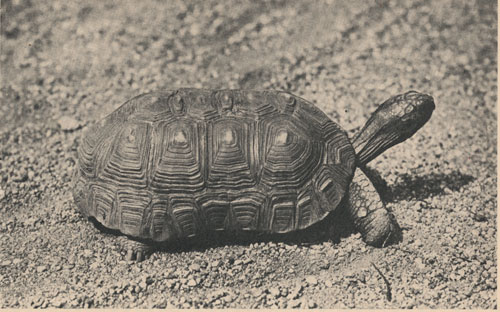
Fig. 23. The South American tortoise (Testudo tabulata), with which the origin of the Galapagos tortoise is doubtless connected. Collected on the Isthmus of Darien in 1924 by Charles M. Breder. Now in the New York Zoological Park.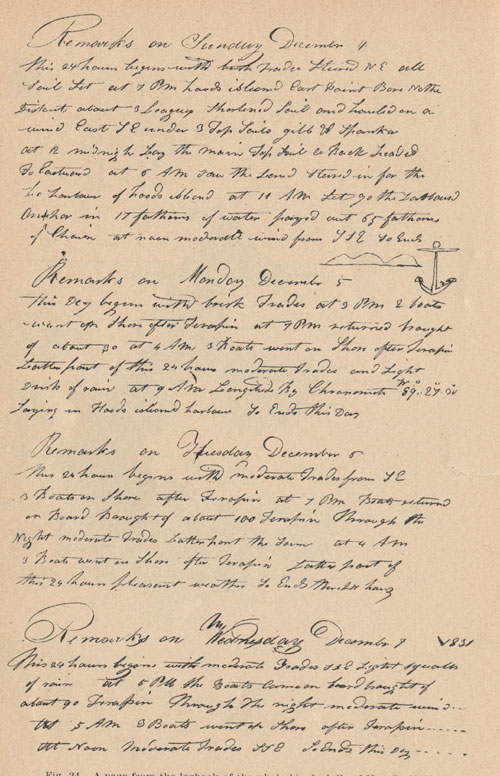
Fig. 24. A page from the logbook of the whaleship Isabella of New Bedford. At hood Island, Galapagos in 1831. Between December 4 and 8, this vessel captured 335 tortoises.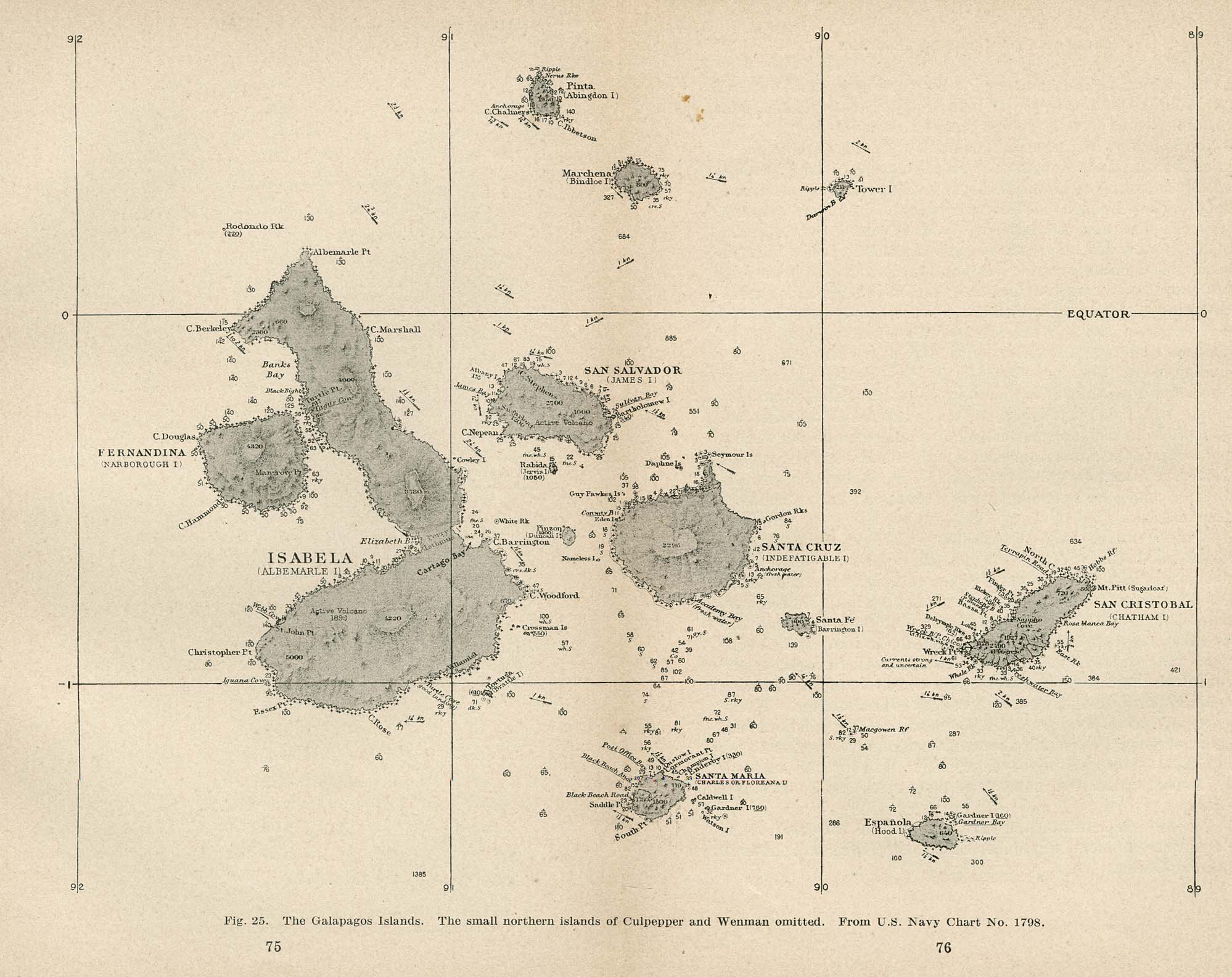
Fig. 25. The Galapagos Islands. The small northern islands of Culpepper and Wenman omitted. From U.S. Navy Chart No. 1798.
|
John M. Bullard, Editor / compiler.Captain Edmund Gardner, of Nantucket and New Bedford : his journal and his family.1958. |
List of Illustrations
|
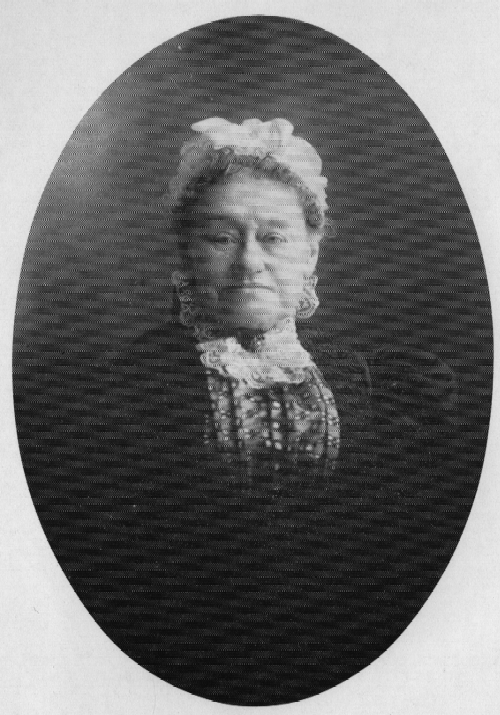
Lydia Hussey Gardner Spooner.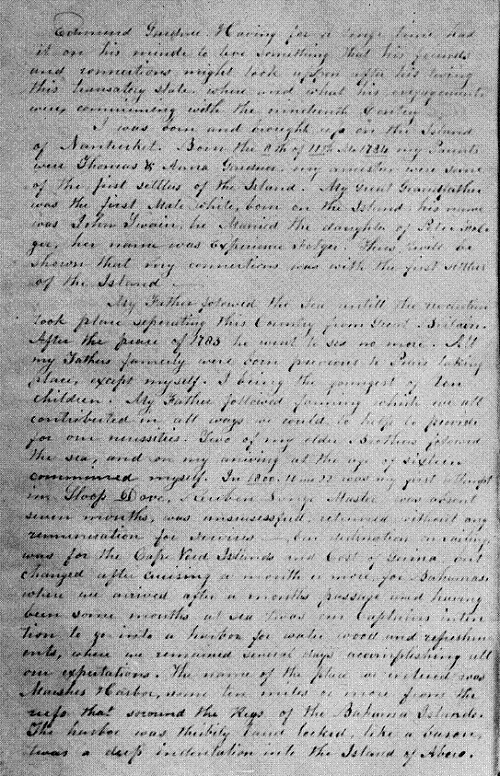 The First Page of the Journal.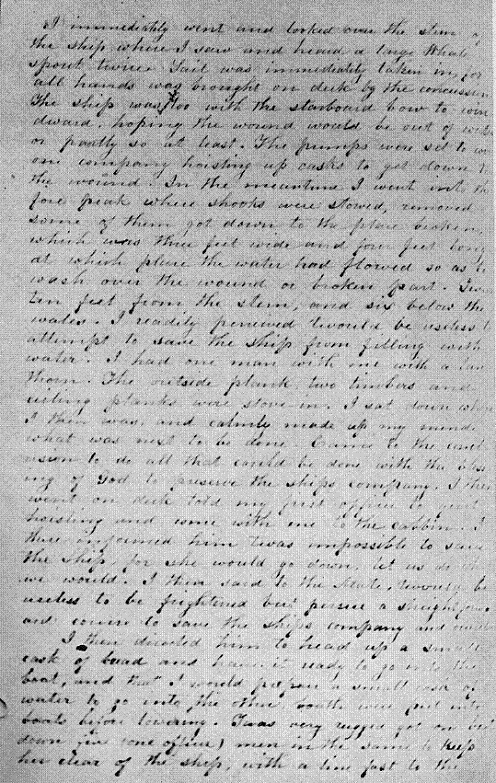 The story of the sinking of the Union.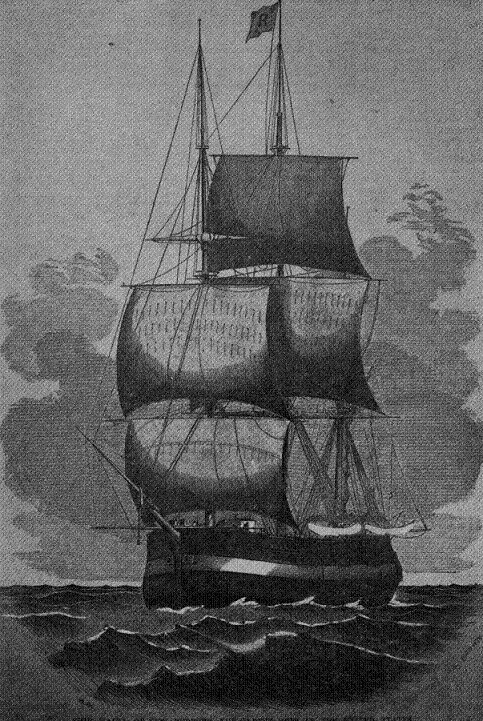 The Ship Maria on which Edmund Gardner served as an officer in his early years.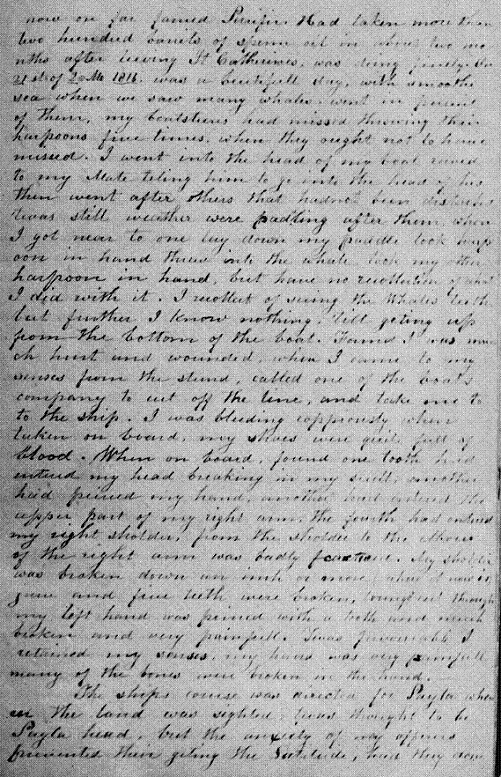 The story of the Encounter with the Whale.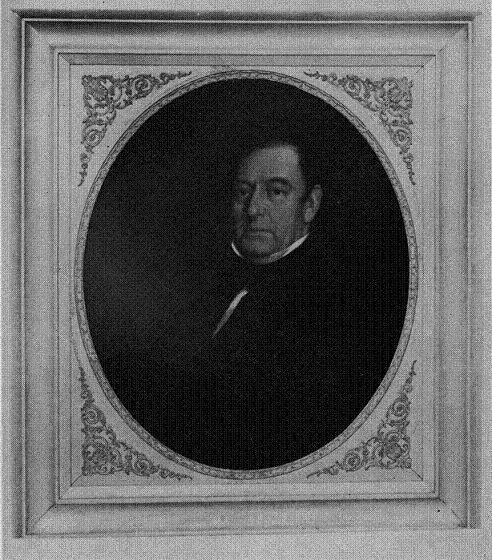
Portrait of Edmund Gardner by William A. Wall
|
NOTES:This page reproduces the images included in books, articles and chapters transcribed for the Plough Boy Anthology of 19th Century American Whaling.
Last updated by Tom Tyler, Denver, CO, USA, Nov 30 2021.
|
|